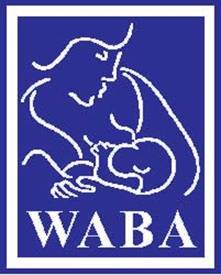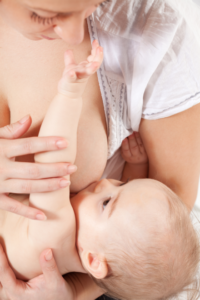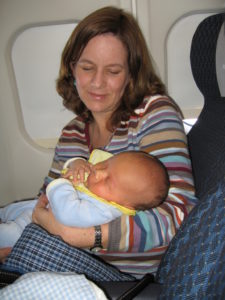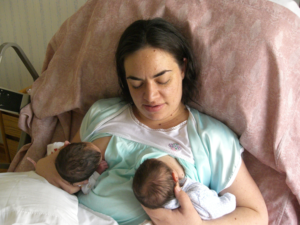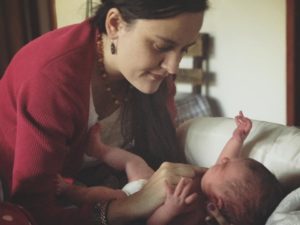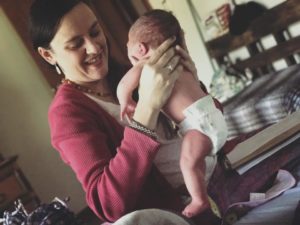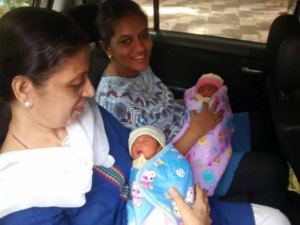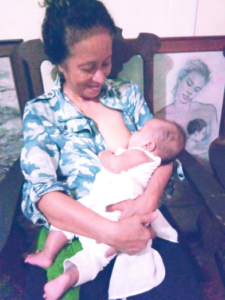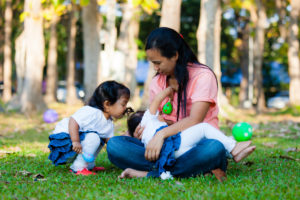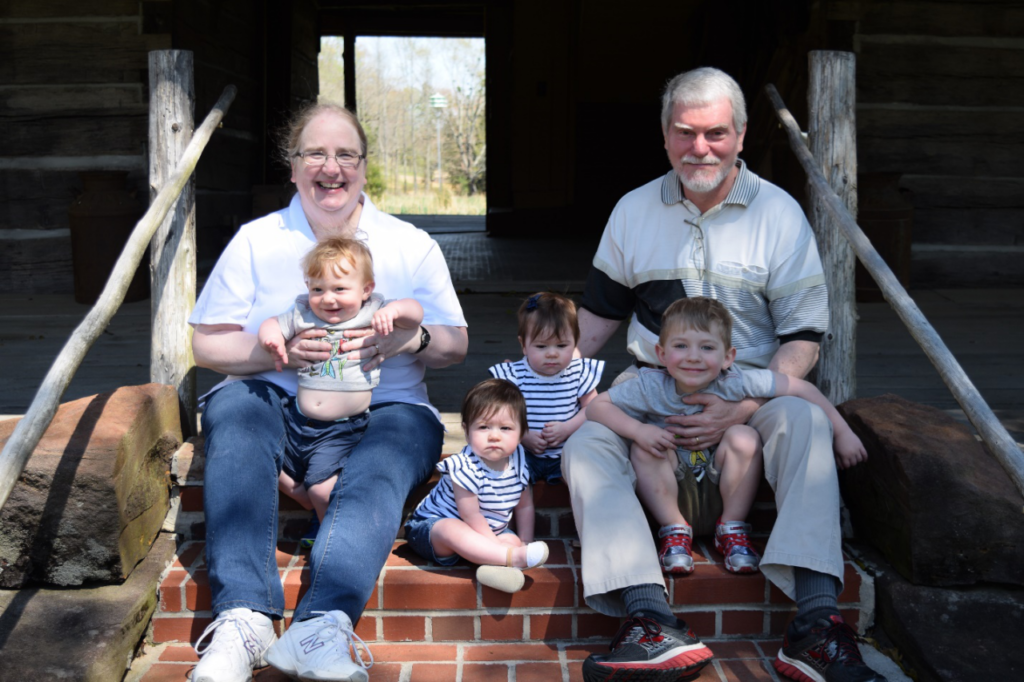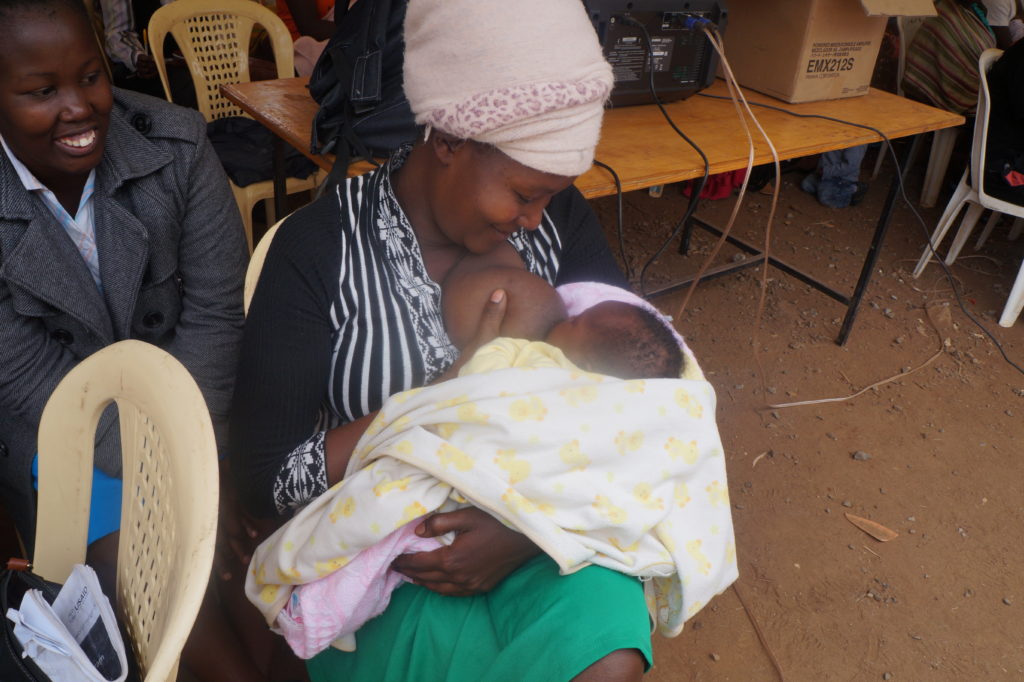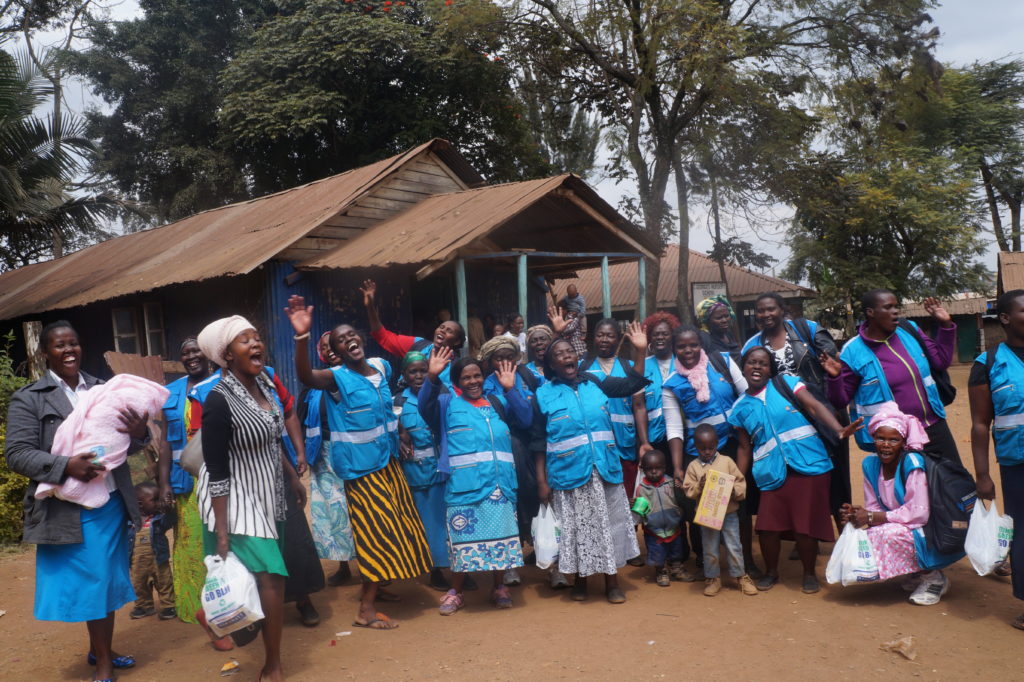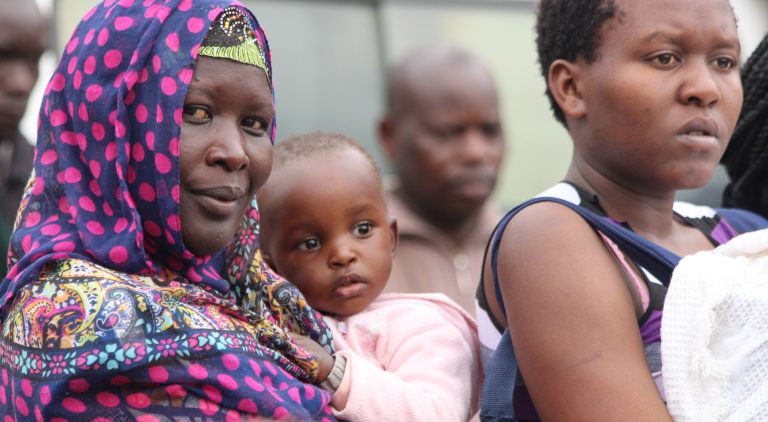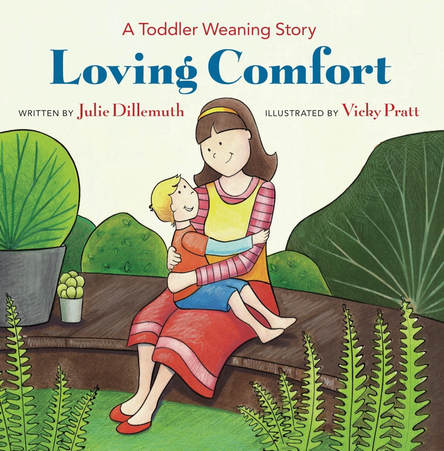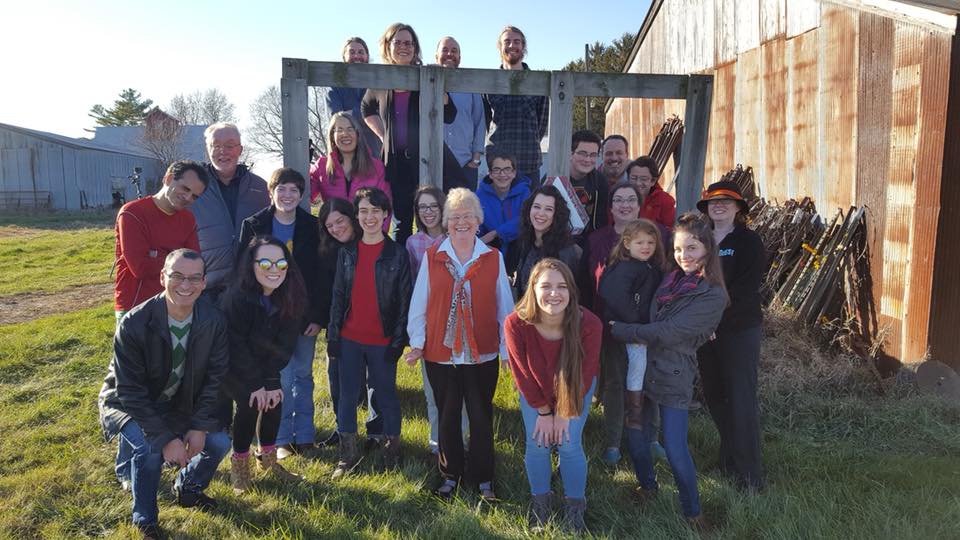Generational WISDOM: Grandmothers and Breastfeeding
“The warmth of her body on mine and the look on her face while feeding, it’s priceless… it makes the world stop for a while every time.” Tammy Photography Walks of Motherhood Project (2015)
It is a common and traditional practice for a new mother to turn to her mother for help, support, and advice as she assumes this new role of caring for a newborn. Not only is this the case for general infant care how-to advice, but it is also common for the new mother to look to her mother for help and support for breastfeeding. For many families around the world, this works well—the grandmother was once a breastfeeding mother herself and brings that “I did it and I know you can, too!” attitude with her. For many other mothers, their mothers did not breastfeed their babies and missed on that kind of personal experience to draw upon to help the next generation. Regardless of whether a grandmother has personal experience with breastfeeding, her support for the new mother is still invaluable, and can come in many forms, from caring for the new mother so she can care for the baby, to linking the new mother to breastfeeding-knowledgeable resources, to just being there with a listening ear and welcoming arms. This issue of the Breastfeeding Mother Support E-Newsletter, Vol 15, No 2 celebrates the role of the grandmother in breastfeeding success. Read the stories of the roles grandmothers have played in the lives of mothers around the world. If you are lucky enough to have had the loving support of your grandmother in your breastfeeding journey, give her a hug and thank her. And if you are now a grandmother, be your grandbaby’s number one cheerleader, and find ways to provide loving support for his or her breastfeeding parent. It is a legacy worth pursuing!
Editors’ Letter
Generational WISDOM: Grandmothers and Breastfeeding Advisors SPOTLIGHT
- Inherited Treasure: Mexican Grandmothers Share their Passion with Breastfeeding, La Leche League ReGoodies (Mexico)
- Secrets of Breastfeeding from Global Moms in the Know, Michaeleen Doucleff (USA)
Mother’s Voices: The essence of breastfeeding support
- Yellow Milk, Janssen (Netherlands/ Cambodia)
- Two Children, Two Breastfeeding Stories, Laura Gettler (USA)
- On Breastfeeding Overseas, Suzi Livingstone (Canada/ Cambodia)
- What Does Breastfeeding Mean to You?, Tammy Nicole Photography (Germany)
Best Practices: Mother support from around the globe
- Supporting Breastfeeding When I Became Doula, Viana Maza (Guatemala)
- Breastfeeding Support for Indian Mothers (BSIM), Adhunika Prakash and Madhu Panda (India)
- The Power of Lactation Massage for Grandmas to Breastfeed, Innes Avellana-Fernandez (Philippines)
- Breastfeeding: The First Food Security, Bindi Borg (Australia/ Cameroon)
Family Matters: A mother’s primary support network
Changemakers: Dreamers, doers and innovators normalizing breastfeeding
- “Look as Powerful and Confident as Breastfeeding Makes you Feel”: Interview with founder of Leche Libre (USA)
- It Takes a Village, Carolina for Kibera (Kenya)
Children’s Corner
Honoring Breastfeeding Advocates
Stay Current: Research, happenings, and breastfeeding in the news
The Breastfeeding Mother Support E-Newsletter is published twice a year by the World Alliance for Breastfeeding Action (WABA) to promote an environment of awareness and support for all mothers to initiate and sustain breastfeeding. It includes stories, new information relevant to the promotion and support of breastfeeding, and highlights efforts across the world by organizations, health workers, businesses, communities, etc. in supporting the breastfeeding mother. The newsletter helps all of us who work in breastfeeding to feel supported and appreciated in what we do and to improve how we help mothers, fathers, families and communities in breastfeeding.
We welcome your suggestions or submissions which may be any actions taken, specific work done, investigations and projects carried out from different perspectives and from different parts of the world that have provided support to women in their role as breastfeeding mothers. Submissions should be between 250 and 800 words, and should include a title and a short biography of the corresponding author (2 to 3 sentences). Please be specific in including details where relevant such as name of places, persons, and exact dates. Photos illustrating a subject specific to your submission also are welcome. Please send to gims_gifs@yahoo.com.
We reserve the right to edit every submission for spelling, grammar and clarity of content.
Please share this newsletter with your friends and colleagues. To subscribe, please email gims_gifs@yahoo.com.
The opinions and information expressed in the articles of this issue do not necessarily reflect the views and policies of WABA, the Mother Support Working Group nor the Newsletter Editors.
EDITORS’ LETTER
Happy New Year! This is our first letter to readers as Editors of the Breastfeeding Mother Support Newsletter. We feel very honored to have been given the task of carrying on this newsletter and we hope we can continue to build upon the high standards established by Pushpa and Rebecca.
This issue focuses on Grandmothers. Some readers may ask why Grandmothers? It is true that mother support goes beyond Grandmothers. As we all know, a mother needs the support from all family members, friends, coworkers, society as a whole. But Grandmothers hold a special, unique relationship to a mother. We can think of them as a link that connects a mother to the past and can bring the generational wisdom to the present. As said so beautifully by James Akre “… breastfeeding is the ultimate nurturing and nutritional link— horizontally with the rest of our human family, and vertically with all who have come before us and all who will come after us.” Just like a Grandmother, we hope we can continue to enrich this link through the sharing of information, stories and resources. We are also planning to take the newsletter a step further to find new ways of sharing, of bringing renewed energy to readers, and finding exciting ways to captivate new ones.
Stay tuned for what’s coming. We hope what we have planned will continue to energize our readers who have been with us for so many years but also draw in new faces and bring a new level of vitality to the newsletter. We are full of ideas of how to grow into different areas and hope you will accompany us on this journey. Bring along your knowledge and expertise and help us venture into new and unexplored paths.
Thank you for your ongoing commitment to breastfeeding. Happy reading!
Warm wishes,
Natalia and Melissa
Inherited treasure: Mexican Grandmothers Share their Passion with Breastfeeding
La Leche League ReGoodies (Paulina Smith, Marichu Villaseñor, Mari Carmen Mariscal, María Elena Calvert, Edith Catarrivas, Renate Guillen, Lourdes Bravo, Mayuya de Anda)
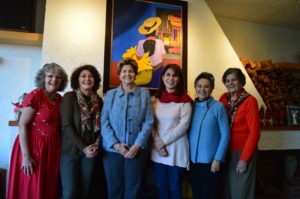
We have been involved in La Leche League Mexico since the 1970’s. We were pregnant together; we led meetings together; we organized toddler meetings. In fact, we have shared much of our lives together. We have seen our children grow, marry, and have children of their own as you will see from the article below. And we still keep sharing! Thirty years ago, after a La Leche League International Conference in Miami, we set up a once-a-month breakfast which we have continued to enjoy ever since. And we gave ourselves the very special name of ReGoodies. We are hoping to travel together next year to celebrate this 30 year milestone.
Paulina
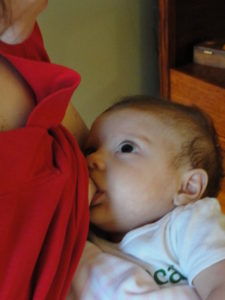 Being a grandmother to breastfed grandchildren has been one of the greatest pleasures of my adult life. Having been immersed in breastfeeding and its benefits when my daughters were babies and having breastfed them, I always hoped and wished that they would recognize the greater importance of breastfeeding a child. And my wish came true! To see not only my daughters breastfeed but also the daughter of my husband and a daughter-in-law by marriage has been the best gift I could be given.
Being a grandmother to breastfed grandchildren has been one of the greatest pleasures of my adult life. Having been immersed in breastfeeding and its benefits when my daughters were babies and having breastfed them, I always hoped and wished that they would recognize the greater importance of breastfeeding a child. And my wish came true! To see not only my daughters breastfeed but also the daughter of my husband and a daughter-in-law by marriage has been the best gift I could be given.
They breastfed while traveling, while working, and always overcoming any challenges they faced. Each one of them has been fully aware of the long term benefits for their children. All of them fed their babies at the breast well into the second year of their lives and lived the experience with love and giving. I am proud of each one of them.
As a grandmother my recommendation to mothers is to be well informed about breastfeeding. This makes the whole experience much easier. Unfortunately there is a lot of information out there which can get between the mother and the baby and potentially interfere with breastfeeding. The other recommendation is to seek information with women who know all about the subject. There is nothing that equals mother-to-mother support.
María Elena
 Being the grandmother of two beautiful children, Luciana and Nicolas, has been a great reward for me. My dear daughter-in-law breastfed Luciana so successfully, even when she had to return to work, thanks to the help of one of my beloved co-leaders. I think it was a wise decision that it was not I, but Edith who was the main source of information and support. Paola felt more comfortable and confident asking Edith about all her doubts. Nicolas was born premature, so the breastfeeding journey with him has been a bit different. Initially he had to be fed through a tube, but the moment he was released from hospital one month ago, he latched-on as a champion, knowing what is best for him. Luciana is five years old and I can see the marvelous influence that LLL has had on her both physically and emotionally.
Being the grandmother of two beautiful children, Luciana and Nicolas, has been a great reward for me. My dear daughter-in-law breastfed Luciana so successfully, even when she had to return to work, thanks to the help of one of my beloved co-leaders. I think it was a wise decision that it was not I, but Edith who was the main source of information and support. Paola felt more comfortable and confident asking Edith about all her doubts. Nicolas was born premature, so the breastfeeding journey with him has been a bit different. Initially he had to be fed through a tube, but the moment he was released from hospital one month ago, he latched-on as a champion, knowing what is best for him. Luciana is five years old and I can see the marvelous influence that LLL has had on her both physically and emotionally.
I do not have words to thank La Leche League for the treasure it not only gifted me and my children, but also to the next generation and beyond. We have inherited this special gift with the knowledge that they are going to be healthier, not only physically but emotionally as well. What I gave to LLL has been returned to my family and me a million times.
Edith
One of the things I treasure most is the fact that when I was a young woman I was able to breastfeed my daughters as long as they needed and wanted, and I am sure this made me grow as a person with self-confidence.
Nowadays, my dear daughters have their own children and as a blessing, I see that breastfeeding is a gift and that it transcends generations. My beloved grandchildren have enjoyed this special long relationship with joy and respect for their unique development.
My daughters have learned how to solve each challenge, with love, patience, and determination. I am so grateful for their commitment as caring mothers.
My sons-in-law have embraced breastfeeding with their support and they are so proud of it. It is a privilege to have breastfed grandchildren that are loving little healthy and happy persons.
I would like to tell each new mother to have confidence in her intuition; to pay attention in what her baby is telling her, observing his body language, respecting his needs; and listening to her heart rather than others’ suggestions. Enjoy this wonderful time getting to know your child and letting the opportunity to establish a special lifelong bond.
Mari Carmen
I am the proud grandmother of eleven grandchildren: six girls and four boys. Their names are Nico, Julian, Maria, Álvaro, Ana, Cecilia, Charlotte, Sofía, Carlos, Lisa, and Camille. Their ages range from 17 years old to one year old. Most of them live in Mexico City but three of them live in Paris, and another three live part time in New Orleans. I try to spend much time with them and enjoy seeing them grow and develop into fine human beings.
To my relief and joy all of the 11 were breastfed, every one of them for at least six months exclusively, and then with gradual introduction of solids for some more months—some of them up for up to a year. My two daughters, Cari and Isabel, and my two daughters-in-law, Flor and Karine, are excellent mothers, juggling their mothering with many commitments, both professional and familial. The four of them have always been close to their children when little and very present in their lives in a different way now that some of my grandchildren are becoming more independent and reaching for their own horizons.
Every time a new grandchild was born I tried to be near his or her mother during the postnatal period, both to be of practical help and to be at their disposition in case they wanted breastfeeding advice and support. Most of time I approached this moment with trepidation, especially with the firstborns of each one, worried that the new mother might refuse to breastfeed, or that people in her environment might dissuade her from breastfeeding or make her give up breastfeeding at the first difficulty.
And in every instance I was happy and relieved that my daughter or daughter-in-law surmounted the problems that she had encountered in breastfeeding and had found satisfaction in giving her child the best start in life. It has been a delight for me to see Cari, Isabel, Flor, and Karine talk about good mothering practices as part of their own beliefs.
I am full of gratitude to La Leche League for having given me as a young woman the knowledge and impetus in my own mothering so that breastfeeding was fulfilling and life-changing for me. And I am also thankful that my daughters and my daughters-in-law have continued such an experience, thus giving lasting benefits to my grandchildren.
Secrets Of Breastfeeding from Global Moms in the Know
Michaeleen Doucleff
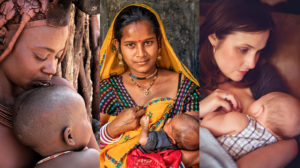
(From left) Mothers from Namibia’s Himba tribe; from Amber, India; and from Washington state. Jose Luis Trisan/Getty; Hadynyah/Getty; Sarah Wolfe Photography/Getty
In many ways, parenting newborns seems instinctual.
We see a little baby, and we want to hold her. Snuggle and kiss her. Even just her smell seems magical.
Many of us think breast-feeding is similar.
“I had that idea before my first child was born,” says Brooke Scelza, an evolutionary anthropologist at the University of Los Angeles, California. “I definitely thought, ‘Oh, I’m going to figure that out. Like how hard can it be?’ ”
Although breast-feeding is easy for some women, for many new moms — including Scelza — it’s a struggle. “I was shocked at how hard it was,” she says.
In a survey a few years ago, 92 percent of women said they had problems in the first few days of breast-feeding. They couldn’t get the baby to latch onto the nipple. They had pain. Sore nipples. And they were worried they weren’t making enough milk.
“This is just surprising because breast-feeding was a critical function for child survival in the past, and if you couldn’t figure it out, your infant was going to be in really big trouble,” Scelza says.
It’s almost like in the U.S. we’ve lost the breast-feeding instinct. That Western society has somehow messed it up. Scelza wanted to figure out why: What are we doing wrong?
Yellow Milk
Janssen
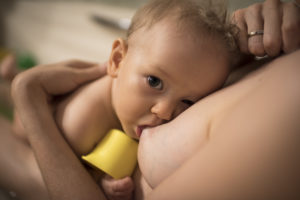 This month our daughter celebrates her first birthday. As I am deciding what kind of cake to bake, I know one thing: it will have to be without my breastmilk as our friends and family will surely not appreciate that as much as she does.
This month our daughter celebrates her first birthday. As I am deciding what kind of cake to bake, I know one thing: it will have to be without my breastmilk as our friends and family will surely not appreciate that as much as she does.
During my pregnancy my breasts enlarged a couple of sizes quite early on. Laughing with my partner, sister, and mother about these bodily changes I also felt anxious. Will my breasts become saggy afterwards; do I want to breastfeed my child; how does latching on feel?
I remember I felt rather indifferent towards breastfeeding. I knew it is dubbed the “white gold,” but I was warned about the “breastfeeding mafia” and read that the start may certainly not be as easy as many think.
None of my friends have children yet and no one around me was able to give me an idea of what breastfeeding feels like. When asked about my plans after birth, I can still hear myself say “I would like to try breastfeeding, but if it doesn’t work out – no hard feelings.” Little did I know that my baby and I would both enjoy the breastfeeding journey so much.
My daughter was born 6 weeks early, very unexpectedly. Coming from the Netherlands and with my mother being a midwife, I had wanted to deliver at home. But instead I gave birth at the hospital and our daughter spent the first 10 days in a heated little cot at the neonatology department as per Dutch procedures.
My baby could not stay with me to breastfeed so my mother told me I had to ask the nurses for a breastpump to stimulate my milk production as soon as possible. There I was in our room, alone, with a bright yellow pump. I had no idea what to do or expect, but wondered why that Medela pump had those beautiful yellow color tones – my favorite color.
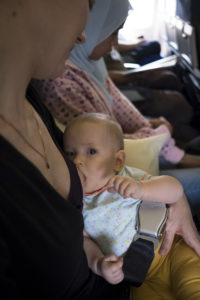 As a premature baby, my daughter was fed a set amount of milk every couple of hours, either by bottle, or through her nasal tube as this takes the least energy. Within a day my milk flow was enough to use my milk only. And within two weeks I had five liters of frozen milk, in the exact same dark yellow color as parts of that Medela pump!
As a premature baby, my daughter was fed a set amount of milk every couple of hours, either by bottle, or through her nasal tube as this takes the least energy. Within a day my milk flow was enough to use my milk only. And within two weeks I had five liters of frozen milk, in the exact same dark yellow color as parts of that Medela pump!
They say latching on and drinking from the breast takes quite some energy and strength. I was encouraged to let my baby search for and smell my nipple once or twice a day, but I was not supposed to expect much as she was likely too small to really drink. But on the second day she did latch on, and on the fifth day she was drinking three times a day from my breast!
The first time my daughter latched on I felt a strange tingling feeling up to my toes, and my womb started to contract. This is what breastfeeding felt like. Looking at my tiny human being, I lost all doubts I ever had about breastfeeding. I might not have been able to carry her to full term, but I did want to do anything to give her the second best start: let her grow on my breastmilk.
When my baby was two weeks old, she drank all nine daily feedings from my breast! Then, I set my goal to exclusively breastfeed her until she was six months old.
I have to admit the first three months were tough. Our daughter cried a lot— she was easily over stimulated and suffered from colic. Nursing seemed the only way to calm her down.
In preparation of my return to work, she had to get used to a bottle too. It took us more than 6 weeks for her to “accept” a bottle. Thinking about her face when seeing and feeling a fake nipple makes me laugh out loud now – she would get so angry. She drank one feeding a day from a bottle for two months, until she discovered a spoon.
I was worried about going back to work and continuing to breastfeed. The office where I work in Cambodia doesn’t have a nursing room and I share room with four other people. Luckily they all (both women and men) are fine when I pump at my desk.
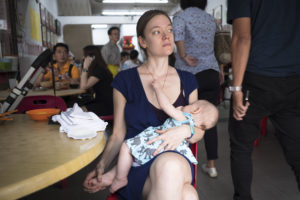 For the last eight months I have pumped at my desk in the mornings. During lunch I go home and in the afternoon my daughter comes to the office with the nanny. I can hear her coming from miles away, as everyone she meets along the way gets super excited seeing a baby. Some colleagues ask me what time she is coming, as they feel tired but get reenergized by spending a minute with her.
For the last eight months I have pumped at my desk in the mornings. During lunch I go home and in the afternoon my daughter comes to the office with the nanny. I can hear her coming from miles away, as everyone she meets along the way gets super excited seeing a baby. Some colleagues ask me what time she is coming, as they feel tired but get reenergized by spending a minute with her.
Some other colleagues have started to ask questions about pumping breastmilk and are now trying to continue breastfeeding as well, returning from their maternity leave. I strongly believe breastfeeding in public has helped to change the attitudes and knowledge of at least my colleagues.
Today, my daughter still drinks at least five times a day (and refuses any other option than milk directly from my breast). I find breastfeeding so convenient and joyful. When people ask how long much longer I plan to continue to breastfeed and seeing how much my daughter enjoys our “chi-chi time,” I can only say that she will decide.
I have never really enjoyed pumping milk itself, but it did teach me a lot. Without pumping, I would never have believed milk can be so yellow. Knowing that my donated, frozen milk has made another family in The Netherlands very happy, satisfies me. In the absence of an informal donor network in Cambodia I started to bake all sorts of pancakes with my milk, something I always thought people only joke about. It works out wonderfully well. And as my daughter feasts on pancakes, I think I know what kind of birthday cake to bake: a pancake-cake.
Two Children, Two Breastfeeding Stories
Laura Gettler
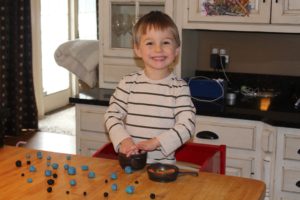 My breastfeeding journey is one that I think many women can relate to. I am a nurse in the Neonatal Intensive Care Unit, so before having my own children, I already knew how amazing breast milk was for babies, especially those born prematurely. It therefore became sort of a no-brainer that I would breastfeed my son. Before his birth, I bought nursing tank tops and bras, nipple cream, and nursing pads in anticipation of having all of the right “accessories” ready so we could smoothly transition to what many people told me was “the most natural feeding method.” Little did I know that babies (and new mamas!) have no idea what they are doing at first! My son had a great latch for maybe a week and a half. After that, he would pull away suddenly, only suck on the nipple, and often refused to nurse on the right side at all. I could not get him to latch correctly no matter what I tried. It became increasingly painful to nurse him and I began to dread when he needed to eat next. Of course, with the post-partum hormones swirling through me, this made me incredibly tearful, angry, and depressed. So I did the next best thing in order to maintain my goal of breast milk-only for the first six months: I pumped. I pumped every three hours on the dot, day and night. Luckily, my son took a bottle without any issues and, although I tried many more times to adjust his latch with professional help, I began to get used to the idea of exclusively pumping. However, this came with many caveats that made day-to-day functioning incredibly difficult. For example, if I went over the three-hour time limit or slept on one side too long, I would get a clogged duct that would take me 30-45 minutes to unclog. Pumping every three hours also meant that my pump went everywhere with me and I had to plan my entire day around my strict schedule. Having to wake up every three hours at night, especially when my son woke up at opposite times (he did not consistently sleep through the night until he was well over a year old), became incredibly exhausting, both mentally and physically. However, even through all of the ups and downs, I exclusively pumped until my son was seven months old. That was my goal for him and I am incredibly proud of making it that long.
My breastfeeding journey is one that I think many women can relate to. I am a nurse in the Neonatal Intensive Care Unit, so before having my own children, I already knew how amazing breast milk was for babies, especially those born prematurely. It therefore became sort of a no-brainer that I would breastfeed my son. Before his birth, I bought nursing tank tops and bras, nipple cream, and nursing pads in anticipation of having all of the right “accessories” ready so we could smoothly transition to what many people told me was “the most natural feeding method.” Little did I know that babies (and new mamas!) have no idea what they are doing at first! My son had a great latch for maybe a week and a half. After that, he would pull away suddenly, only suck on the nipple, and often refused to nurse on the right side at all. I could not get him to latch correctly no matter what I tried. It became increasingly painful to nurse him and I began to dread when he needed to eat next. Of course, with the post-partum hormones swirling through me, this made me incredibly tearful, angry, and depressed. So I did the next best thing in order to maintain my goal of breast milk-only for the first six months: I pumped. I pumped every three hours on the dot, day and night. Luckily, my son took a bottle without any issues and, although I tried many more times to adjust his latch with professional help, I began to get used to the idea of exclusively pumping. However, this came with many caveats that made day-to-day functioning incredibly difficult. For example, if I went over the three-hour time limit or slept on one side too long, I would get a clogged duct that would take me 30-45 minutes to unclog. Pumping every three hours also meant that my pump went everywhere with me and I had to plan my entire day around my strict schedule. Having to wake up every three hours at night, especially when my son woke up at opposite times (he did not consistently sleep through the night until he was well over a year old), became incredibly exhausting, both mentally and physically. However, even through all of the ups and downs, I exclusively pumped until my son was seven months old. That was my goal for him and I am incredibly proud of making it that long.
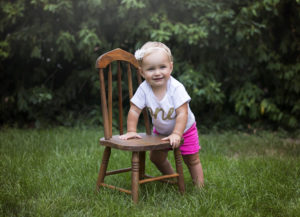 Having gone through the exclusive pumping journey with my son, I was absolutely determined to breastfeed when I found out I was pregnant with my daughter. Before we were discharged from the hospital, I made sure all of the lactation consultants saw her and that her latch was perfect. As it turns out, she had no problem breastfeeding and I was thrilled! However, I delayed introducing a bottle to her until she was eight weeks old and, as a result, she absolutely refused to take one. I tried different nipples, different bottles, different caregivers, different times of day; you name it, we tried it! In other words, it was the exact opposite experience I had with my son! This became quite the challenge when I had to go back to work. Luckily, I was only working part-time and both my husband and my co-workers were very understanding. In particular, my husband was incredibly supportive. At one point, I was only working weekend shifts and he would bring her to nurse (in the car in the parking garage!) three to four times during my 12-hour shift. He was a trooper and so was my daughter! I obviously had two very different experiences with breastfeeding, which reflects the fact that every single baby is different. My second experience was beautiful, challenging, and incredibly fulfilling. Although my breastfeeding journey ended recently (my daughter self-weaned at 16 months old, somewhat earlier than I had expected her to), I am so grateful for having been able to nurse her for as long as I did. It provided such an indescribable connection and comfort for both of us and I will honestly miss it.
Having gone through the exclusive pumping journey with my son, I was absolutely determined to breastfeed when I found out I was pregnant with my daughter. Before we were discharged from the hospital, I made sure all of the lactation consultants saw her and that her latch was perfect. As it turns out, she had no problem breastfeeding and I was thrilled! However, I delayed introducing a bottle to her until she was eight weeks old and, as a result, she absolutely refused to take one. I tried different nipples, different bottles, different caregivers, different times of day; you name it, we tried it! In other words, it was the exact opposite experience I had with my son! This became quite the challenge when I had to go back to work. Luckily, I was only working part-time and both my husband and my co-workers were very understanding. In particular, my husband was incredibly supportive. At one point, I was only working weekend shifts and he would bring her to nurse (in the car in the parking garage!) three to four times during my 12-hour shift. He was a trooper and so was my daughter! I obviously had two very different experiences with breastfeeding, which reflects the fact that every single baby is different. My second experience was beautiful, challenging, and incredibly fulfilling. Although my breastfeeding journey ended recently (my daughter self-weaned at 16 months old, somewhat earlier than I had expected her to), I am so grateful for having been able to nurse her for as long as I did. It provided such an indescribable connection and comfort for both of us and I will honestly miss it.
Laura lives in northern Indiana (United States), is a mother of two, wife, and registered nurse working towards her Master’s degree as a Family Nurse Practitioner. Laura strongly believes in the benefits of breastfeeding for both mother and baby.
On Breastfeeding Overseas
Suzi Livingstone
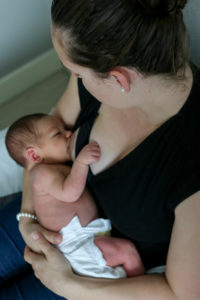 When I got pregnant with my first son, I already knew I wanted to breastfeed. My mother had breastfed me, friends who had recently welcomed children were breastfeeding, and I was generally aligned with a “hippy” philosophy on all things birth- and baby-related. I knew that the WHO recommended nursing until age two, so I figured that was a pretty good plan.
When I got pregnant with my first son, I already knew I wanted to breastfeed. My mother had breastfed me, friends who had recently welcomed children were breastfeeding, and I was generally aligned with a “hippy” philosophy on all things birth- and baby-related. I knew that the WHO recommended nursing until age two, so I figured that was a pretty good plan.
I attended a breastfeeding course near the end of my pregnancy and remember being surprised that the instructor spent so much time trying to convince us that nursing was a good idea; what I wanted were actual practical facts! How would I know when to nurse? How would I know when baby had had enough? Should I switch sides?
Mercifully, aside from a little nipple pain in the first weeks, my breastfeeding journey had a smooth start. My son fed enthusiastically, if briefly, and although he routinely got a faceful of milk from coming off too abruptly, he also managed to double his birth weight by nine weeks. I enjoyed breastfeeding and particularly appreciated how convenient it was to be able to comfort my son using only my body.
 I don’t think I truly appreciated it, however, until we packed up our entire lives and moved from Canada to Cambodia when he was five months old.
I don’t think I truly appreciated it, however, until we packed up our entire lives and moved from Canada to Cambodia when he was five months old.
It turns out that my children’s lives are characterized by frequent massive transitions: annual international travel; routine crossing of time zones; and many, many different homes. Breastfeeding has been one of few constants for them, and indeed for me. Regardless of where we are in the world, no matter which of a hundred beds they fall asleep in, my children have had access to the same source of comfort every day of their lives.
Breastfeeding helped my eldest feel rooted and connected to me through the major events of moving across the world and the subsequent arrival of a sibling, as well as through the minor traumas of everyday toddler life. I cannot imagine dealing with jet lag and the massive emotions that come with arriving in a new place without the comfort of nursing.
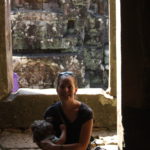 I ended up breastfeeding my firstborn past age four, well beyond my original goal, because it was just so helpful and lovely and familiar. After over two years of tandem feeding, I am now nursing only my smallest. His one feed before bed every night continues to be a moment to exhale, to connect peacefully after a day of ups and downs, and to revel in his fleeting smallness. I am so grateful that he still needs and wants me to help him fall asleep, even as he grows ever more independent.
I ended up breastfeeding my firstborn past age four, well beyond my original goal, because it was just so helpful and lovely and familiar. After over two years of tandem feeding, I am now nursing only my smallest. His one feed before bed every night continues to be a moment to exhale, to connect peacefully after a day of ups and downs, and to revel in his fleeting smallness. I am so grateful that he still needs and wants me to help him fall asleep, even as he grows ever more independent.
I love that my sons’ lives have begun with such connection to me, and that that remains true irrespective of where we find ourselves in the world. Breastfeeding has been our stability, our safe space, our daily rhythm in a life with few permanent patterns. It’s a beautiful chapter of our story.
Suzi Livingstone is a Canadian mother of 2, raising her sons in Cambodia. She is passionate about birth and breastfeeding and works as a doula in Phnom Penh.
What Does Breastfeeding Mean to You?
Photographer Tammy Nicole, based in Munich, Germany specializes in motherhood photography. In honor of World Breastfeeding Week (2015) she put together a video using some of her favorite photos and included quotes from the mothers she photographed on what breastfeeding means to them. She hopes that through her photographs she can transmit how beautiful and natural breastfeeding is.
For more information, please visit her website.
Supporting Breastfeeding When I Became Doula
Viana Maza
I grew up in a breastfeeding world— since I was very young my mom worked to provide advice and support to other breastfeeding mothers. She organized support groups, telephone counseling sessions, trainings for health professionals, etc. So, for me it was very “easy” to become a breastfeeding expert when I became a mother and attended support groups. I got to know a whole world of breastfeeding support and I felt very comfortable supporting from there, from the vision of “how to do it well” and “how you should not do it.” In this way, I supported many moms for several years, even via email and then they thanked me for having “saved their breastfeeding” and I felt very good about it.
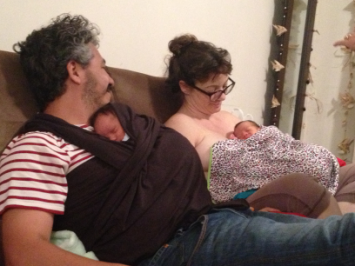 When I became a Doula, I learned another way to support— by being. I began to understand more the value of who mothers are, who they were, and the great talent that each one has of being a mother. I learned how the mother emerges after childbirth and how there is not a single “right way” to do things. I learned how to simply be, stay present with them, and not “teach” absolutely anything because she already knows it. How not to “do” for her, and instead how to empower her to decide. I learned how mothers always “choose” the right thing (the right thing for them) when they are given the tools to do it.
When I became a Doula, I learned another way to support— by being. I began to understand more the value of who mothers are, who they were, and the great talent that each one has of being a mother. I learned how the mother emerges after childbirth and how there is not a single “right way” to do things. I learned how to simply be, stay present with them, and not “teach” absolutely anything because she already knows it. How not to “do” for her, and instead how to empower her to decide. I learned how mothers always “choose” the right thing (the right thing for them) when they are given the tools to do it.
I learned to place myself from another perspective. To give the mother the right to breastfeed and to obtain from her environment everything necessary to decide and to do it freely. I also learned why many mothers cannot “breastfeed,” and I work on that every day but not directly with mothers. For that, I participate in political, social, and health platforms to advocate what mothers and babies need to exercise their right to breastfeed freely.
I also understood that breastfeeding is not an isolated issue. It is part of a continuum. Breastfeeding does not start the day the baby latches on to the breast. It is also part of pregnancy, childbirth, and the care that the mother receives. I learned how labor DOES have an influence on the emotional tools that the mother brings with her to breastfeed her baby and also the influence it has when a mother and baby have been separated. That does not mean that mothers and babies who had a necessary intervention and a separation cannot regain their breastfeeding, but when the physiology is respected, breastfeeding flows like a river and in most cases without complications.
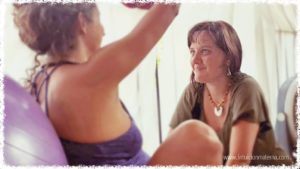 Breastfeeding is much more than milk. Many mothers now feel pressured to “succeed” at breastfeeding. It is extremely detrimental when society suggests that “breastfeeding is best,” and yet only holds mothers responsible for its success. Breastfeeding is a bond, it is love and what nourishes the most is the warmth from the mother. Breastfeeding is not just milk … it is urgent to work on maternity and paternity rights in accordance with world recommendations on the duration of breastfeeding.
Breastfeeding is much more than milk. Many mothers now feel pressured to “succeed” at breastfeeding. It is extremely detrimental when society suggests that “breastfeeding is best,” and yet only holds mothers responsible for its success. Breastfeeding is a bond, it is love and what nourishes the most is the warmth from the mother. Breastfeeding is not just milk … it is urgent to work on maternity and paternity rights in accordance with world recommendations on the duration of breastfeeding.
Thus, mothers now never feel that I taught them how to breastfeed, they do not thank me for saving them. Now, they feel that they did it by themselves, and that gives them power, self-esteem, and ability to continue raising their children for the rest of their lives. I am only a support, a channel, a pillar, and it is they who feel the achievement as their own. I do not teach mothers anything, because I am not “the one who knows.” My wisdom was used to breastfeed and raise my babies. Those who I do train are other doulas, health professionals, and people who want to accompany mothers.
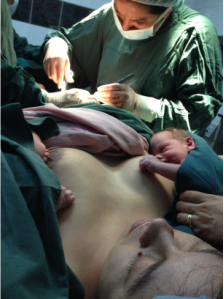 I have accompanied so many women who were eager to breastfeed and they and their babies were exposed to unnecessary medical interventions, medicated, sedated, manipulated, disempowered, infantilized, that when trying to support them they have so few tools to be able to achieve what they want and ask for your help because they need someone to “tell them how to do it.” What you find are babies too covered, asleep, and disconnected so that they do not know how to do it either. The work becomes extremely difficult. We try the most basic things: undressing mother and baby, helping them to find each other, to re-fall in love, to smell each other and avoid anything that could separate them. This way the mother is born again and the baby again finds the will to live.
I have accompanied so many women who were eager to breastfeed and they and their babies were exposed to unnecessary medical interventions, medicated, sedated, manipulated, disempowered, infantilized, that when trying to support them they have so few tools to be able to achieve what they want and ask for your help because they need someone to “tell them how to do it.” What you find are babies too covered, asleep, and disconnected so that they do not know how to do it either. The work becomes extremely difficult. We try the most basic things: undressing mother and baby, helping them to find each other, to re-fall in love, to smell each other and avoid anything that could separate them. This way the mother is born again and the baby again finds the will to live.
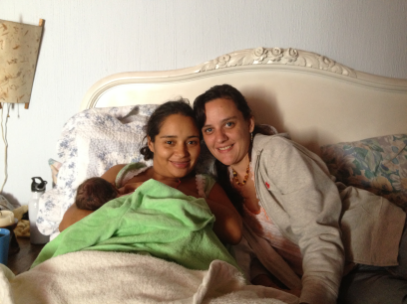 So now, in addition to being a mother, with a lot of experience in breastfeeding, psychologist and doula, I am doing an apprenticeship to become a midwife. This way I am able to ensure that mom and baby are not separated, not exposed to unnecessary medical interventions, and that during the sacred hours of birth and postpartum the mother receives everything she needs because she KNOWS how to raise her baby. She does not need to be taught anything, only to respect her rhythms, needs, physiology, and receive no interventions. Mothers need their tribe, let’s not leave them alone. We all deserve to exercise our right to breastfeeding and every being that comes into the world deserves that their mother gets what she needs so that she can decide to give her milk and her love.
So now, in addition to being a mother, with a lot of experience in breastfeeding, psychologist and doula, I am doing an apprenticeship to become a midwife. This way I am able to ensure that mom and baby are not separated, not exposed to unnecessary medical interventions, and that during the sacred hours of birth and postpartum the mother receives everything she needs because she KNOWS how to raise her baby. She does not need to be taught anything, only to respect her rhythms, needs, physiology, and receive no interventions. Mothers need their tribe, let’s not leave them alone. We all deserve to exercise our right to breastfeeding and every being that comes into the world deserves that their mother gets what she needs so that she can decide to give her milk and her love.
Viana Maza Chavarria has an undergraduate degree in Clinical Psychology and a master’s degree in Public Health. She is a Doula, and a Doula teacher specializing in gender studies. She is currently finalizing her studies to become a midwife in Mexico. She is mother to Ariana, 15, and Luca, 8.
Breastfeeding Support for Indian Mothers (BSIM)
Adhunika Prakash and Madhu Panda
Breastfeeding Support for Indian Mothers (BSIM) is a peer-to-peer support group for breastfeeding parents, their partners, and family members. The aim of the group is to empower families with appropriate breastfeeding information through the use of online platforms as well as community events.
The initiative began in June 2013 as a Facebook Support Group and today it reaches out to nearly 60,000 members. We have also conducted group meetings in more than ten cities across the world.
The BSIM “Team” consists of Administrators, Moderators, and Peer Counsellors (PCs) and currently has around 30 people who actively manage the day-to-day operations of the group behind the scenes as well as answering queries from the group. The BSIM team is based in different time zones, which enables us to help mothers at any given hour of the day.
Profile of Founding Members:
Adhunika Prakash is a management graduate who always knew she wanted to help people in need. After the birth of her son, she found herself counseling other friends about breastfeeding based on the information she had gained during her pregnancy. As more and more people started reaching out to her, she chose the digital media to reach out to more mothers seeking support. Within a year of her older child’s birth, BSIM was born. She pursued a certification course from University of San Diego to become a Certified Lactation Educator and Counsellor and now uses the knowledge she gained to support breastfeeding parents.
Madhu Panda is a qualified Chartered Accountant who works in the Finance Department at Apple. She joined BSIM as a co-administrator when the group had 300+ members and has played a vital role in bringing it to the nearly 60,000 member base it stands at today. Madhu’s breastfeeding experience stretches across nearly 8 years of breastfeeding her two sons, including breastfeeding when pregnant and continuing to breastfeed when returning to a full time job.
Accomplishments:
We have been featured on National Television and in many leading publications in India for the work we do.
Our founder Adhunika Prakash was invited by Facebook to talk about the work we do at an event in New Delhi which highlighted the social impact Facebook Groups can have.
The biggest accomplishment however is the number of mothers we have helped take informed decisions during their breastfeeding journey and the positive feedback we receive from our members. Below we share some of these success stories.
What Can Others Learn from Our Project:
Anyone can make a difference. When we started this initiative, we didn’t have an inkling that we could make such a huge impact. A lot of us wonder how much of an impact just one breastfeeding parent can make, but if we work as a team, we can make a difference.
What We Hope for the Future:
Since most members of our team have young families and other commitments, most of our work has been focused on online support via the FB group. With time, we would like to expand our offering to include more groups meetings, workshops, seminars and conferences.
In addition, we would like to work on advocacy with hospitals, government agencies, companies, corporations, and other organizations/entities involved in the care and treatment of babies and children to promote breastfeeding.
For more Information:
Email: contactbsim@gmail.com
Website: http://www.bsim.org.in
Facebook: https://www.facebook.com/groups/breastfeedingsupportforindianmoms/
Twitter: http://twitter.com/BSIM_tweets
From Raksha…
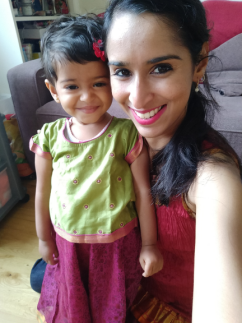 My baby had just completed six months of exclusive breastfeeding. I was on top of the world and very emotionally tired at the same time. We had a long uphill journey so far. I posted on my Facebook page of this proud moment briefly describing the issues we faced when a friend of mine read my post and added me to BSIM. And then my life changed—for the better.
My baby had just completed six months of exclusive breastfeeding. I was on top of the world and very emotionally tired at the same time. We had a long uphill journey so far. I posted on my Facebook page of this proud moment briefly describing the issues we faced when a friend of mine read my post and added me to BSIM. And then my life changed—for the better.
Just before BSIM came into my life I had faced a very difficult personal situation which had left me stripped of confidence and highly anxious, almost on the verge of depression.
Even though I had got through the first set of breastfeeding battles I was in a dark place. Very few people understood or empathized with me. Even my doctor suggested starting formula when my daughter went on a nursing strike. That’s when BSIM started being my guide and moral support. And then I read the plight of many new mums, some similar to me, some even worse. I couldn’t bear to think of another mum struggling alone like I did so I started answering questions when I saw I could help. This process of paying it forward really helped me heal. Knowing that I helped another mum brought back my confidence bit by bit.
Then came the inevitable problems that comes with a bigger baby, nursing in public, teething, sleepless nights, etc. I can quite easily say that if not for the timely guidance I got from BSIM I would’ve probably given up breastfeeding at the one year mark and then regretted it for the rest of my life. Eventually BSIM gave me that push to get my Breastfeeding Mother Supporter certification.
Even if one leaves out the knowledge aspect that one gains from the group, the solidarity and support that one gets by sharing and reading the journeys of others gives one hope and motivates a mum who might otherwise be in a non-supportive environment. One cannot put a price on the sisterhood of breastfeeding.
___________________
From Bhargavi…
My school friend added me to this group the week after I gave birth. It is a wonderful destiny to be a part of this group, and I learn more every day. My son was born via c-section at 37 weeks because my fluid levels were down. He was at a very low birth weight, probably 2 kgs, and in the neonatal intensive care unit (NICU) for four days. After joining the BSIM group I got the basics of breastfeeding but the lactation consultant and the NICU pediatrician who saw him said he didn’t have the strength to suck. I realized only when I went to my mom’s place and had a personal consultation with a lactation consultant and my pediatrician that I had no supply issues— it was only because he didn’t have strength to suck. This was an important turning point as it pushed me to start pumping with a schedule. It was extremely hard to pump and immediately after feed for the first two months. My concentration was only bringing up his weight, so I had to supplement with formula to make sure he gained the weight he needed. This group has thought me perseverance, patience, and a can-do attitude that breastfeeding is possible when you believe in yourself and trust your body. After the fourth month I started to wean him of formula and did it successfully in his fifth month. All this time my mother was definitely a pillar of support. In the early days she used to check over me to make sure I I had milk but then when I shared facts and other articles from this group she believed and trusted me. After those two months unfortunately I had to come back to my in-laws house, and my mother-in-law wasn’t that receptive to breastfeeding. After a point, she would say, “Oh formula is there. We will mix it and give it to the baby,” but my husband stood and fought for me. Now after a year she understands the importance and allows me to feed even at 15 months postpartum. I would definitely be indebted for all the help each and every one have given on this forum and I am happy to advocate more about this group as awareness is important to not fall into the formula trap unnecessarily.
I thank you for the wonderful opportunity given to share about my journey which was a experience by itself. I wish all women get this support from family and friends to overcome the apprehensions that they have about naturally feeding their child.
___________________
From Shru…
My best friend added me to this beautiful group of Breastfeeding Support for Indian Mothers a day after my delivery. I feel so proud to breastfeed my twins exclusively for first six months and we are still going strong in our nursing journey. People around kept telling me that since there are two babies the milk would fall short of what they needed. It was BSIM that gave me the confidence and helped me understand that my milk would not be divided by two, rather it would be multiplied for two.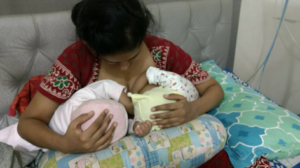 I always knew I wanted to breastfeed because it was normal and natural but BSIM actually helped me understand the nuances of breastfeeding, cleared my doubts, and gave me motivation on days I felt like giving up. It takes a lot of perseverance and patience to breastfeed twins.
I always knew I wanted to breastfeed because it was normal and natural but BSIM actually helped me understand the nuances of breastfeeding, cleared my doubts, and gave me motivation on days I felt like giving up. It takes a lot of perseverance and patience to breastfeed twins.
That being said, any breastfeeding journey would be incomplete without family support. I delivered my twins in August 2016. Right from my pregnancy till today my mother-in-law has been a solid support especially in my breastfeeding journey: from staying up with me every night to ensuring that I was eating healthy and was always hydrated. She, along with my husband, ensured that the babies and I were healthy and happy. After two months postpartum I started pumping once a day so that I could catch up on some sleep. My mother-in-law fed the pumped milk to my babies at that time so that I could catch up on a decent nap. She stayed up during my early postpartum days to help me with tandem feeding set up, helped burp the babies, and put them to sleep. Initially her understanding of breastfeeding was different to mine (which generally would be the case of any woman from her generation) but she always respected my decisions and appreciated my breastfeeding goals. When I went back to work after six months postpartum, she, along with my husband, have been instrumental in my pumping (at work) journey as well. She sterilized the bottles and warmed the milk appropriately and fed the babies while I was away. My family and I owe a lot to this wonderful breastfeeding forum, BSIM, without which my breastfeeding journey would have just stopped before it even began.
___________________
From Sangeeta…
My story of supporting grandmothers includes my mother and her mother! I am fortunate to have had my maternal grandmother stay with us during the delivery of my twins and for some time after. I was told even during my pregnancy that I come from a long line of breastfeeders and that I wouldn’t have a problem with supply, even for my twins. My grandmother is a traditional woman but with progressive ideas for her time. She has maintained a diary of how she brought up her three children and seven grandchildren, adding notes to it all along the way! Both my mother and grandmother are privy to the concept of demand increasing supply and constantly encouraged me to feed on demand. They were also aware that babies cry for reasons other than hunger and had a wealth of suggestions on burping, nappy-free time, tummy time and the like. My grandmother told me, “You shouldn’t feel guilty if you want to feed formula, but you may not have to because we all had enough milk, so will you.” Her traditional explanation was that if God gave me twins, he would give my body the means to feed them, which is in line with science too. She, and later my mother, breastfed all their babies till 24 and 18 months, sixty and thirty years ago respectively! My mother (along with my husband) took full charge of every aspect of their care other than feeding with input from my grandmother. This allowed me to focus on exclusively breastfeeding them. My grandmother knew the importance of hydration and would keep offering me potions tempered with fennel and garlic, considered galactagogues. I don’t know if these actually worked, but it was nice to be pampered (possibly the last time I would be pampered for a long time to come!). At the time, like most new mothers I thought I was going through the most difficult phase of my life. But on hindsight, I reflect that my babies’ grandmother and great-grandmother ensured we sailed through this experience and for that, I am eternally indebted to them.
___________________
From Shyamala…
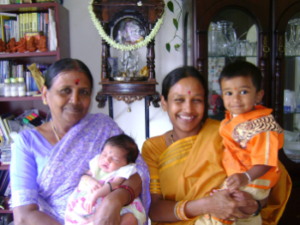 When I had my firstborn, I called my mother for help. She did her best in helping me prepare from taking me to the best gynecologist in town to indulging me in shopping for material in my third month of pregnancy so I could get feeding/maternity tops tailor-made. She, with all good intentions, asked around about all the things she should do to help me. Finally, when she came to help me, she came with tons of information: some were myths, some facts. With my first born, it was a learning process for her too, learning everything from scratch as it was 30 years since she had her own child. She was a quick learner. We both worked together in finding out what was a myth and what wasn’t. When my daughter was born two years later, anyone that asked about solids before six months was told off by her. “Exclusive breastfeeding for six months! Did you not read about it in the newspapers?” she would say to anyone that asked me. She was supportive of me nursing in public at temples, airports, buses, trains, or when we went out visiting friends and family. I was never asked to use a nursing cover. She knew by then that my supply was good, so she never brought up the topic of formula. If I had to go out, she would ask me to pump and leave some milk at home so she could feed the baby. This was the same lady that was skeptical about pumps and expressed milk. My daughter went on to breastfeed for 4.5 years and my mother did spend a major amount of time with me during that period. Even though sometimes she used to get frustrated with my daughter not eating properly, she never asked me to wean her. Now when I think back, what she did then didn’t appear big, but she kept all the doubters at bay and quietly supported me in my breastfeeding journey by being there in the background and helping me in whatever way she could. I am thankful to her for being there for me when I needed her the most and silently supporting me even without me having to ask for it.
When I had my firstborn, I called my mother for help. She did her best in helping me prepare from taking me to the best gynecologist in town to indulging me in shopping for material in my third month of pregnancy so I could get feeding/maternity tops tailor-made. She, with all good intentions, asked around about all the things she should do to help me. Finally, when she came to help me, she came with tons of information: some were myths, some facts. With my first born, it was a learning process for her too, learning everything from scratch as it was 30 years since she had her own child. She was a quick learner. We both worked together in finding out what was a myth and what wasn’t. When my daughter was born two years later, anyone that asked about solids before six months was told off by her. “Exclusive breastfeeding for six months! Did you not read about it in the newspapers?” she would say to anyone that asked me. She was supportive of me nursing in public at temples, airports, buses, trains, or when we went out visiting friends and family. I was never asked to use a nursing cover. She knew by then that my supply was good, so she never brought up the topic of formula. If I had to go out, she would ask me to pump and leave some milk at home so she could feed the baby. This was the same lady that was skeptical about pumps and expressed milk. My daughter went on to breastfeed for 4.5 years and my mother did spend a major amount of time with me during that period. Even though sometimes she used to get frustrated with my daughter not eating properly, she never asked me to wean her. Now when I think back, what she did then didn’t appear big, but she kept all the doubters at bay and quietly supported me in my breastfeeding journey by being there in the background and helping me in whatever way she could. I am thankful to her for being there for me when I needed her the most and silently supporting me even without me having to ask for it.
___________________
From Dia…
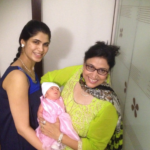 I am currently in the weaning stage of my 3.5 year old daughter. If it wasn’t for BSIM I would have weaned her at eight months of age. BSIM is the reason that I breastfed my child till today with no other milk introduced till three years. It helped me cross so many hurdles in my journey, motivated me, and clarified my doubts whenever needed. Not only that, it also laid the foundation for my career that I went on to become a Certified Lactation Educator Counsellor. BSIM played such a huge role in my life but it did not come into my life until my daughter was almost eight months. Till then my mentor and my role model was my mom, my daughter’s nanny, who told me how she had fed me for a year, my sister for 2.5 years and my brother for a year. I had made up my mind that I would exclusively breastfeed my child for six months and then I would see how it went. My mother was with me when I delivered and saw me starting my journey of motherhood. She definitely came with her own set of myths but they weren’t very harmful. The main one was you should eat well in order to make sufficient milk for your child as I hardly ate anything in the first few months due to postpartum depression, so it was ok, I guess. I clearly remember an instance where my mom rescued my child from the myths of our society and even pushed away the doctors. My daughter suffered from severe colic till three months of age and her pediatrician on the tenth day of life asked me to time her feeds and breastfeed only after two hours to prevent colic. Being a first time mom with no knowledge about breastfeeding, I followed his advice blindly for a day or two only to be badly scolded by my mother to not make the baby cry and listen to my baby rather than some doctor. I remember her telling me that I was not thinking and I should not have asked the doctor what to do when the baby cries and gets out of control in just 45 minutes after the last feed. It made sense and since then I just breastfeed on demand. My mother gave me the strength to mother my child well. Though she went back to her city after 26 days postpartum, she was always available and with her love she helped me overcome depression. She says that even she has learnt a lot about breastfeeding through my journey. My daughter loves her nanny to bits and vice-versa but the best part about her nanny is that she never imposes her beliefs and parenting style on me. She has given me the freedom to discover it on my own and be the mother I wish to be for my child. This is the reason my respect for her has increased manyfold.
I am currently in the weaning stage of my 3.5 year old daughter. If it wasn’t for BSIM I would have weaned her at eight months of age. BSIM is the reason that I breastfed my child till today with no other milk introduced till three years. It helped me cross so many hurdles in my journey, motivated me, and clarified my doubts whenever needed. Not only that, it also laid the foundation for my career that I went on to become a Certified Lactation Educator Counsellor. BSIM played such a huge role in my life but it did not come into my life until my daughter was almost eight months. Till then my mentor and my role model was my mom, my daughter’s nanny, who told me how she had fed me for a year, my sister for 2.5 years and my brother for a year. I had made up my mind that I would exclusively breastfeed my child for six months and then I would see how it went. My mother was with me when I delivered and saw me starting my journey of motherhood. She definitely came with her own set of myths but they weren’t very harmful. The main one was you should eat well in order to make sufficient milk for your child as I hardly ate anything in the first few months due to postpartum depression, so it was ok, I guess. I clearly remember an instance where my mom rescued my child from the myths of our society and even pushed away the doctors. My daughter suffered from severe colic till three months of age and her pediatrician on the tenth day of life asked me to time her feeds and breastfeed only after two hours to prevent colic. Being a first time mom with no knowledge about breastfeeding, I followed his advice blindly for a day or two only to be badly scolded by my mother to not make the baby cry and listen to my baby rather than some doctor. I remember her telling me that I was not thinking and I should not have asked the doctor what to do when the baby cries and gets out of control in just 45 minutes after the last feed. It made sense and since then I just breastfeed on demand. My mother gave me the strength to mother my child well. Though she went back to her city after 26 days postpartum, she was always available and with her love she helped me overcome depression. She says that even she has learnt a lot about breastfeeding through my journey. My daughter loves her nanny to bits and vice-versa but the best part about her nanny is that she never imposes her beliefs and parenting style on me. She has given me the freedom to discover it on my own and be the mother I wish to be for my child. This is the reason my respect for her has increased manyfold.
The Power of Lactation Massage for Grandmas to Breastfeed
Innes Avellana-Fernandez
At 62 I was the 27th Grandma who opted to breastfed a one year old girl for 2 months. After two years (in 2017), I wet-nursed again and this time for a 3 month old baby boy for a week.
We are now 29 Filipino Grandmas who experienced the power of breastfeeding beyond the birthing age. Our group is called “Hot Grandma Club” (you can read more about this story in the previous issue of the Newsletter).
Basically our intent, with pure hearts, is to support working daughters to be free from stress while focusing on their work outside home. The biological moms can continue breastfeeding while they are back home mostly in the evenings and weekends. We, as grandmothers, pursue breastfeeding during daytime.
How does Arugaan, my mother-to mother-support group organization, gift the power of breastfeeding to Grandmothers ?
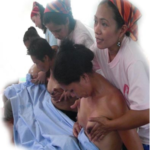 The first step is to have an Intensive Breastfeeding Counseling session for Grandmothers who want to breastfeed through a PowerPoint presentation by explaining why breastfeeding is important, its benefits, and the consequences of formula feeding and its pitfalls. As soon as they understand “who gains, who loses” we continue to lead them in learning the anatomy and physiology of the breast, and how prolactin and oxytocin (known as the love or de-stressing hormones) work with breastfeeding production and supply.
The first step is to have an Intensive Breastfeeding Counseling session for Grandmothers who want to breastfeed through a PowerPoint presentation by explaining why breastfeeding is important, its benefits, and the consequences of formula feeding and its pitfalls. As soon as they understand “who gains, who loses” we continue to lead them in learning the anatomy and physiology of the breast, and how prolactin and oxytocin (known as the love or de-stressing hormones) work with breastfeeding production and supply.
Then, we tackled the myths: no milk, less milk, inadequate milk. Once they comprehend that breastfeeding is 90% psychological and 10% physical, we pursue the management of breastfeeding in working women and how Grandmas can fully support motherhood.
As they are convinced we go to the next level: full body massage intervention with emphasis on stimulating the mammary glands and the corresponding acupressure points found in the back, the foot and the hands.
The Lactation Massage on the Breasts and Areola is the last chapter in the intervention. It contains 11 Techniques of different strokes and varying pressure correspondingly done with the gracefulness of hands or fingers, and appropriately.
The Power of Lactation Massage intervention is meant to boost confidence and capability to nurture and lactate.
We start by calming the woman’s body with comforting massage and gentleness of the healing hands. It is the best mother-to-mother support in action for women who wish to come back to the power of breastfeeding.
The back massage is the first step in the relactation process and involves a warming-up stimulus for the mammary glands. There is a sensitive nerve center between the scapula (shoulder blade) and the armpit. Thus, for every hard stroke, we console with a comforting massage. We call it “for every pressure a corresponding pleasure.”
Part of the back massage is the detox massage on the lower level of the body, above the buttocks. Most women’s work and stress settles on this most vital part of the body. Indeed detox works— unloading happens in the toilet after 4 hours.
The full body massage covers an hour of body works.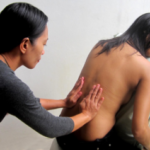
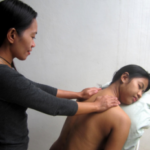
We do a lot of body massage with different strokes on the foot and legs, too. The pressure points of the mammary glands can be found on the foot.
Thereafter, we let the Grandma lay on her back. We work on the hands and arms while discussing her concerns. The hand massage stimulates the mammary gland points and the nourishment points.
Next, we do the relaxing head massage including the face to release doubts and confusion as well as stimulate the prolactin hormones. This way the Grandma’s mind is at work commanding a mantra: “Yes, I have breastmilk. Yes, I will be able to breastfeed my Grandchild soon”.
The head and shoulder massage is most soothing, releasing the hardness of the muscles and stiffness. This loosens the tired body and gets it ready for the best breastfeeding position with a relaxed muscle tone.
After the full body massage, her face brightens and she looks 5 years younger. Many have claimed that it is the most relaxing moment in their lives. It affirms her readiness to her forthcoming new role: Breastfeeding Grandma. By the time we start the frontal act: Breast Massage for Lactation stimulus, the Grandma’s body is most willing for the most awaited breast massage.
We have labeled every stroke or technique totaling 11 kinds: specific for the breast alone and also for the areola alone. Always keeping in mind a very important rule: avoid touching the nipple, which is the most sensitive and sacred part of the breast. These 11 techniques have been developed by Arugaan and require some training in how to carry them out effectively. If you would like to know more about these techniques, please contact us*.
There are 3 strokes or techniques in the beginning called “big butterfly, small butterfly and winged” which are applied to both breasts using both hands. The next step focuses on each breast individually using different strokes/techniques called “comforting massage” or “drive me crazy”. Then, we apply the 2 critical strongest stimulating lactation points called “an inch away from the nipple” in the areola and 6 fingers above the nipple. Next is the lovable stroke using what we call the “diamond technique”. What follows is the areola massage using only special finger strokes. At this point we always say, “ask permission to enter the sacred grounds”. Then, the most important steps are what we call the key strokes to open the pores of the nipple and ultimately will begin to extract drops of milk.
We teach the Grandma how to do the breast massage on herself, using a sitting position. She applies it at home daily. To fast-track their readiness we provide them with galactogogue soups made from indigenous food recipes, and sometimes we bring in a newly born for Grandma to wetnurse to enhance the flow of breastmilk. The time it takes for a Grandmother to begin to produce milk varies from person to person. We have seen some producing milk within one week if she is psychologically prepared and convinced of the power of her body and follows closely all steps of the intervention (breastfeeding counseling, joining the Eat Right seminar, consuming galactagogues, daily lactation massage, introducing a newly born to her first breastfeeding experience, and managing a gradual transition from daytime to nighttime breastfeeding).
At the onset, we also use the drip drop with expressed breastmilk while Grandma starts to breastfeed. As of note, the biological mom is not around the house when Grandma is breastfeeding her grandchild as otherwise the child would most probably want to be with the mother and not the Grandmother. We also stress the importance of no bottles, teats, nor pacifiers. We ensure they understand that this is taboo. We share with them our Milk Code law that explains well the nipple confusion and risks to health of the infants and young child.
The bonus for Grandmas who take back the power of breastfeeding is Rejuvenation. Their face, breasts, and body look 5 to 10 years younger due to the miracle of breastmilk, which provides stem cells and glutathione (an important antioxidant). Above all breastfeeding is a peaceful act that will bring joy and love across generations.
*The methodology described above has intellectual copyright. Please contact the author (innes.sea@gmail.com) for permission before sharing or using.
Ines Avellana Fernandez, as representative of her organization Arugaan (Philippines), writes from her experiences and expertise in breastfeeding support for thousands of moms whom she has touched and transformed with her healing words, hands and heart.
Breastfeeding: The First Food Security
Bindi Borg
Each year, sub-optimum breastfeeding results in 800,000 infant deaths. By any standards, this is a serious human rights and development issue.
The evidence for the role of breastfeeding in the prevention of undernutrition and infant death is well-documented. Moreover, the function of breastfeeding in protecting children and women from overweight, obesity, and subsequent non-communicable diseases is becoming increasingly clear. Thus, breastfeeding is a highly effective intervention for infant health, as well as maternal health. Not being optimally breastfed, or being artificially fed, poses risks for the health of mothers and children.
If breastfeeding is such an effective intervention in infant health, and is supported by a number of international human rights instruments, why does it receive relatively little attention in development education and practice? Is it because it doesn’t cost anything or generate any money on an ongoing basis, meaning no projects with big-sticker funding, no aid that is tied to the purchase of donor country goods and services, and less “repeat business”? Is it because it’s “women’s business,” or because it is considered “natural” and something that mothers and babies should be able to do automatically? Is it because men are less likely to be involved in breastfeeding promotion and protection? There is no doubt that aid is allocated in mysterious ways, but it is perplexing indeed to see that a simple, culturally appropriate intervention that protects the health of women and children and empowers mothers is not enthusiastically embraced by development professionals.
Responsibility for breastfeeding programming has typically resided in the health sector. However, perhaps for the reasons above, it is often secondary to other health objectives. How can we breathe life into breastfeeding in the development sector? One way might be to consider breastmilk as food, and incorporate breastfeeding into the important discourse around food and nutritional security.
In earlier times, food security was all about food production, with little regard for how food was used to ensure and improve nutrition. The food security discourse is slowly changing to include nutritional security, but it has yet to include food and nutritional security for the most vulnerable, namely infants and young children.
The first food security is breastfeeding. Infants and young children who are breastfed have a safe, secure, and optimal food source for at least the first two years of life, even in a context of more general food insecurity, such as in humanitarian emergencies. Food security in the form of breastfeeding in these early years is essential for achieving development goals. Lack of recognition and support for this first, most basic building block of food security compromises the health and wellbeing—indeed the very survival—of infants and young children during their early years, and puts their long-term health, and the health of their mothers, at risk as well. In addition, by failing to recognize the importance of breastfeeding, development programming (including, ironically, food security programming) can undermine breastfeeding by increasing work and time burdens for women, thereby making it more difficult for them to breastfeed optimally.
Breastfeeding promotion and support demands a paradigm shift in the conceptualization and policy design of food security. Until the discourse around food security includes infants and young children, it must be considered inadequate, and failing to deliver on the goal of reducing inequality to improve the health and wellbeing of all children, and ultimately, of all people.
References
Black RE, Victora CG, Walker SP, Bhutta ZA, Christian P, de Onis M, et al. Maternal and child undernutrition and overweight in low-income and middle-income countries. Lancet (London, England). 2013;382(9890):427-51.
Salmon L. Food security for infants and young children: an opportunity for breastfeeding policy? International breastfeeding journal. 2015;10(1):7-13.
Ball O. Breastmilk Is a Human Right. Breastfeeding Review. 2010;18(3):9-19.
Bindi Borg is a development practitioner who has worked in West Africa, the Balkans, South-East Asia and the Pacific for the past twenty years, and is based in Cameroon at present. Currently, she is writing a PhD on prevention of malnutrition in children under two years of age.
On Becoming a Grandma
Melissa Clark Vickers
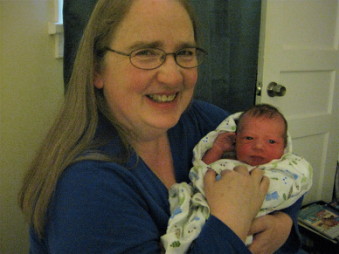 I am about to embark on a great adventure—one that not just anybody can experience. The eligibility criteria is based on choices I made decades ago, combined with choices made more recently by others. My choice—and success—at having babies years ago set this adventure in motion, and my daughter’s choice—and pending success—at having a baby of her own completes the criteria list.
I am about to embark on a great adventure—one that not just anybody can experience. The eligibility criteria is based on choices I made decades ago, combined with choices made more recently by others. My choice—and success—at having babies years ago set this adventure in motion, and my daughter’s choice—and pending success—at having a baby of her own completes the criteria list.
What is a grandma anyway? Part genetic continuation of the species, part sharer of great—and not so great—wisdom, part whimsical fun, and part exhilaration in having lived long enough to see my daughter marry her childhood sweetheart and carry the next generation to term.
I know that I’ll be the grandma of a little boy—Grayson Alexander Ethan Graf. I know—or have been told, anyway—that Grayson is an active little fellow. I know that he is already loved by his Mom and Dad, and I know that I love him as well. And I can imagine playing with this little tyke and rolling around on the floor with him, reading him books, teaching him to cook, watching him take delight in the world around him. And yet these images are but a blur, missing the key ingredient of a shining face. Will he look like Merrilee? Alex? Or maybe his grandparents. I saw my own parents in many pictures of my children when they were young. Or maybe we just see what we want to see, and see those faces we know so well.
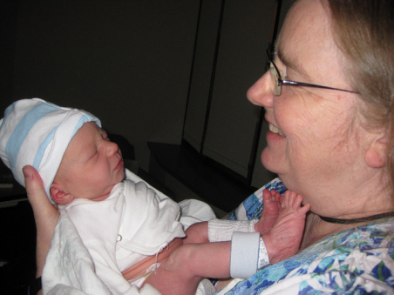 And while I can imagine what I might do with Grayson, I don’t know what he’ll want to do with me. What will pique his interest? Snails and puppy dog tails? The dinosaurs standing ready to protect him in his room? The electronic IT world his daddy knows so well? Or maybe the artistic creativity of his mom.
And while I can imagine what I might do with Grayson, I don’t know what he’ll want to do with me. What will pique his interest? Snails and puppy dog tails? The dinosaurs standing ready to protect him in his room? The electronic IT world his daddy knows so well? Or maybe the artistic creativity of his mom.
I wish my own parents were still alive to see their great-grandchild—and to see their granddaughter in her new role—and see me in my new role. So much of my parents is embedded in me and my daughter, so perhaps those genes that survive through two generations will become a part of Grayson, too. I hope so!
Right now, the biggest mystery of all is when Grayson will join us on this side of the world. We’re ready, and the calendar says he ought to be ready. Already showing wisdom beyond his age, only he will know when he’s ready to greet us.
We’re waiting, Grayson!
Part 2
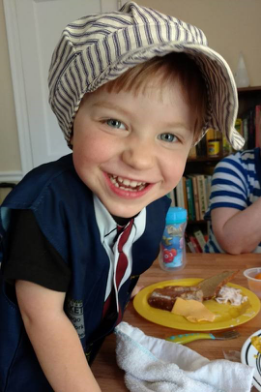 Part One of this tale was written in the days just before Grayson arrived; Part Two comes a year and a half later. In a matter of months Grayson will celebrate his second birthday, and I will have two years of grandmotherhood under my belt.
Part One of this tale was written in the days just before Grayson arrived; Part Two comes a year and a half later. In a matter of months Grayson will celebrate his second birthday, and I will have two years of grandmotherhood under my belt.
What an amazing journey it has been—for baby, his parents, and his grandparents. Any life experience changes us, but perhaps none so profoundly as the birth of a child. I’ve experienced those kinds of life-altering events with the births of my own children, but I’m not sure I was truly prepared for how my life—how my outlook on life—has changed, all because of Grayson’s birth.
I was lucky to have witnessed the transformation firsthand—I was at my daughter’s side as she brought Grayson into the world. It was a difficult labor and delivery. Long and painful for Merrilee, and while I didn’t actually go through the labor and delivery, in many ways I “felt” her pain and discomfort as only a mother can. She was amazing, however, as was Alex, her husband, close by her side. Together, he and I made a pretty good team, though there were times that I’d have to remind myself to move out of his way to let him be her Number One support.
I got to watch another kind of transformation right after the birth as well. Because of some potential complications during delivery, as soon as the cord was cut Grayson was whisked across the room to be checked over by the waiting neonatologists. Merrilee could only watch from a distance with a grayish combination of fatigue and fear and need to hold her newborn apparent on her face. Alex followed his son across the room, and then back to Merrilee when the okay was given.
As she held her newborn son for the first time, I witnessed life and color return to her face. And clearly Grayson knew he was back where he belonged as well. I helped get him to the breast, where he latched on beautifully—as if he knew he was the grandson of a breastfeeding supporter.
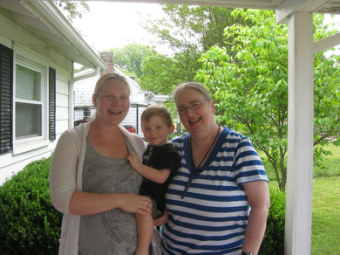 And while I was able to assist this first “reattachment” back to the mom he’d been fully dependent on for nine months, I really can’t take credit for it—anymore than I could take credit for taking two magnets and creating the natural attraction that pulls one to the other. Mom and baby each knew they needed the other, regardless of inexperience.
And while I was able to assist this first “reattachment” back to the mom he’d been fully dependent on for nine months, I really can’t take credit for it—anymore than I could take credit for taking two magnets and creating the natural attraction that pulls one to the other. Mom and baby each knew they needed the other, regardless of inexperience.
Those first few months were not without challenges—how can new motherhood not be a challenge? And while my maternal instincts wanted to fix everything for my daughter, my grand-maternal awareness realized that she didn’t need me to fix things for her as much as validate—that she was fully entitled to feel frustration and joy, sometimes simultaneously, and that she held the keys to resolving those challenges for herself. Sometimes the resolution was no more than the realization and acceptance that what she was experiencing was totally normal. There’s a great sense of relief that comes with understanding that your experience as a parent is a shared one with other parents who have gone before you. That’s the stuff that La Leche League has been made of for 60 years!
The grandma role is definitely an interesting one—it’s a balance between unconditional support, gentle nudging, mama bear protectiveness, empathy, and frustration at not being able to just “fix” everything. But it’s worth every minute of it!
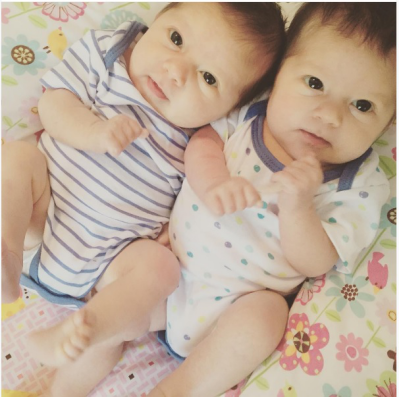 Postscript: A lot has happened since I started this “travelogue” of my journey as a grandparent. Not only do I revel in my relationship with soon-to-be 3 year old Grayson, who now sincerely tells me, “Grandma, I love you!” and has declared that I am his “biggest and bestest friend,” but I’ve learned firsthand that it is possible to love more than one grandchild at a time—much as parents learn that they can learn to love more than one child at a time. Grayson has two cousins, two-month-old twins Lynley McKenna and Emma Grace Vickers. And in the next few weeks, we’ll welcome Grayson’s baby brother Oliver William Edison Graf to the family.
Postscript: A lot has happened since I started this “travelogue” of my journey as a grandparent. Not only do I revel in my relationship with soon-to-be 3 year old Grayson, who now sincerely tells me, “Grandma, I love you!” and has declared that I am his “biggest and bestest friend,” but I’ve learned firsthand that it is possible to love more than one grandchild at a time—much as parents learn that they can learn to love more than one child at a time. Grayson has two cousins, two-month-old twins Lynley McKenna and Emma Grace Vickers. And in the next few weeks, we’ll welcome Grayson’s baby brother Oliver William Edison Graf to the family.
There’s no real surprise that there’s enough love to go around for all these grandbabies. I look forward to watching the three new ones grow, and to building that loving relationship with them that is such a treasure with Grayson.
One More Update:
Since this article first appeared in La Leche League’s Breastfeeding Today, I have had the great pleasure of witnessing the birth of Oliver. Unlike Grayson’s birth in a hospital setting, with a cascade of interventions that added to both the length and intensity of labor and delivery, Oliver was born at home, with an amazing midwife, doula, and me in attendance for a water birth. Merrilee’s husband, Alex, was once again her major support, and even Grayson was on hand (when an assistant doula wasn’t playing with him in the next room). Whereas Merrilee’s first labor was more than 50 hours long, with four hours of pushing before the obstetrician delivered Grayson by forceps, this second labor—with Merrilee surrounded by loving support—was only six hours long with only 23 minutes of pushing. Oliver arrived peacefully and immediately went to his mother’s awaiting arms, and he took to breastfeeding like he had been born for that moment.
I love being a grandma! There is nothing that compares to little hands reaching up for me to hold and hug—and nothing that compares to watching my children (and their spouses) parent my grandchildren lovingly. My only regret is that the twins live 12 hours away (by car), and we see them much more infrequently than we do the boys (who live two hours away). We have been able to get all of the grandchildren together five or six times in the last year and a half, and the chaos that ensues is wonderful.
First published in Breastfeeding Today (http://breastfeedingtoday-llli.org/on-becoming-a-grandmother/) on May 31, 2016, and reprinted here with permission.
A Grandmother’s Angst
By a concerned and loving Mother and Grandmother*
I remember hearing not too many years before actually becoming a grandmother that grandparenthood is our reward for all those years of parenting–a magnificent gift filled with wonder, happiness, and joy.
In truth, I have come to experience that, though true, grandmotherhood can be a difficult challenge; one that I did not anticipate until completely immersed. I found myself describing this challenge as a kind of angst, a quasi-queasy sense that somehow everything I treasured and valued was now being redefined, reimagined, and—gulp—rejected….
My husband and I raised our five living children (and sadly, our sixth child who died of a terminal illness as an infant), guided by attachment parenting. I breastfed my babies into toddlerhood and two children up to three years of age. We practiced proximity of sleep and shared sleep with our babies, toddlers, and young children to varying degrees; we chose to discipline our children following the principles of loving guidance. We adhered to the belief that a baby’s need for its mother was as profound as its need for food, keeping my young nurslings with me, and minimized my separation from my toddlers and very young children.
We raised our children as unique individuals and responded to their needs as they arose, knowing intuitively that especially in their early months a baby’s wants are its needs. We were very fortunate in that our children were for the most part very calm and happy and not particularly high need or challenging to raise, and with the exception of one in the twos and teenage years. Some parents would actually tell us not so jokingly that our babies, toddlers, young children, pre-teens, and teens were not normal.
Then our children left the nest in their post-college years and began to rebel. Suddenly we felt as if we no longer played a role in their lives. If we did not phone or e mail we would not hear from them. They would come home for visits and holiday celebrations, and, of course, wedding and other family celebrations. But our importance as role models decreased each year more and more, which is as it should be. I remember being told with tears in my eyes that the sign of successful parenting is when a child can comfortably leave the nest and not need to turn to you for physical and emotional support.
I knew then that my angst as a parent of adult children and soon to be grandparent had begun. I felt the full impact of this inevitable moment when my children began to connect with their significant others, paired off (four out of five now married), and developed very meaningful and for the most part positive peer networks. We knew then that the bulk of our impact as parents had come to an end. What I didn’t realize was that there is an unconscious level of influence that does continue. Just recently my daughter, who two months ago delivered her second child, said, “I grew up knowing that breast milk is the healthiest thing for babies.” This very same daughter had made some life choices with her husband that were different from our own, and was somewhat judgmental of our choices as parents. She was very influenced by our daughter-in-law whose parenting style—especially when it came to nighttime parenting—was not particularly attachment-oriented.
My oldest son and his wife had our first grandchild. My daughter-in-law breastfed him when home and pumped breast milk for him when at work or away from him. She worked two long days away from him with family members caring for our grandson and later granddaughter in her absence. She read the Womanly Art of Breastfeeding and, I believe, used it as a reference. But she adamantly rejected the concept of shared sleep even with the new safety guidelines in place. She even rejected the concept of proximity, valuing instead the teaching of self-soothing by letting her babies cry themselves to sleep. My husband reminds me that they didn’t do so from the immediate newborn period, but very soon afterward it became a guiding principle.
My son recently shared with me that he feels he gave his children a gift of learning to self-soothe in infancy because now they have learned how to sleep at night during naps and how to go back to sleep on their own. My internal reaction was…where did I go wrong? How did he leave the nest not valuing the emotional night time needs of babies? Unfortunately, when my daughter had her oldest, despite my sharing alternative resources with her to read and decide for herself, she was influenced by my son’s and his wife’s choices. I knew that I could not criticize their choices, and that I had to close my mouth and unfurrow my brow. I somehow knew that voicing any sign of outward concern or disapproval could end up damaging my relationship with my child and spouse and possibly impact their willingness to allow me to be an involved and connected grandparent.
I discovered quickly that when we were with our grandbabies, both my husband and I had to follow strict bedtime and other routines when putting our grandchildren to sleep at night or for naps. After reading a predetermined number of stories, giving them milk, and singing a lullaby, I was to place baby in bed, turn on the white noise, and walk out…. I was to ignore any protests, especially during the sleep training period. I shed literally buckets of tears. I had and still have countless sleepless nights over the price my grandchildren were paying for not being held and soothed to sleep once sleep training began at four to five months of age.
Sleep training was part of a general sense of rigidity in scheduling and lack of flexibility in the fluidity of life. This was and can still be very difficult to witness. I have sensed that my children perceive that this is difficult for me and so are not always so comfortable leaving the grands with us for too long.
At one point a few years back, I contemplated not visiting till painful periods like sleep training passed, to minimize the emotional upset for me and the impression of disapproval that I might have been giving my children. I remember being told by a wise relative at one point to keep the big picture in mind that infancy and toddlerhood pass and that our grandbabies grow into grandchildren and that we want to preserve the long term relationship with them and their parents.
I am not left without hope as I have happily noticed that my children have grown in their parenting, that though they would still fight me on shared sleep as an example, they have learned to listen to their babies and be a bit more flexible with some things. I rejoice at the smallest of those things when it happens, and try to model flexibility in my own interactions with my grandchildren, always being careful to ask permission.
I realize that I can reinforce their growth in their parenting by commenting positively on the things they choose to do or say that are wonderful. They are caring and loving parents, despite some of their upsetting decisions, and my perception of their lack of sensitivity.
My latest challenge is fast approaching. My daughter decided to take on a big job while pregnant and will be going back to work when baby is three months old. I suspect she will be putting the baby in daycare. Her first son had a nanny and lots of one-on-one care. This time I don’t quite know what the ratio might be. I worry the stress will affect her milk supply and the reduced amount of relaxed time with him might hurt their bond and baby’s emotional wellbeing. And I know that sleep training will happen far too quickly in order to help facilitate the needs of a rested working parent.
My daughter hasn’t said whether she has, in fact, chosen day care for him. I am sure she does not want to tell me if she has made this decision because she knows how I feel. I must find a way to be loving and supportive, and yet not turn into an anxious pile of tears. I do trust her to know what is best for her baby and family even if in my heart I may feel her choices are mistaken, and not what I made for my family. Someone once told me that we had the opportunity to raise our own children and make decisions that could potentially screw them up…now it is our children’s turn to do the same.
I just wish I could let it go. I wish I could not hear my grandbabies cries and not have them sear my heart. I wish I could say to my daughter, “I will come and take care of baby and bring him to you to nurse.” I also wish I were not in partial dread when I hear that another of my children is expecting and making the choices that so many millennial adults make today. And then I remind myself how unnerved my own mother was when she learned my babies were being caught by a midwife. And so it goes…
I wish for wisdom and strength to understand and respect my children’s choices and patience to find the words and gestures that allow myself expression and self-protection while offering loving support…this is my grandmotherly prayer.
* Because of the sensitivity of this story, the author decided to remain anonymous. If you would like to communicate with her, please send your comments to the editors who will then forward them on to her.
“Look as Powerful and Confident as Breastfeeding Makes you Feel”: Interview with founder of Leche Libre
“When I started Leche Libre, I wanted to help women breastfeed easier and with awesome style, but I also wanted to help women own and celebrate the power of our bodies,” explains Andrea Newberry in an email interview. In December 2014, Andrea Newberry founded Leche Libre, a Chicago-based clothing company that creates fashionable apparel for the breastfeeding mother.
How many children do you have and how did your journey with breastfeeding change you?
I have two kiddos. Thora is now 7 and Otto is 5. I loved breastfeeding for a million reasons. I loved that it was natural, convenient, and cheap! I loved bonding with my babies while nursing and it always made me feel so nurturing to them. It also felt so powerful. Being pregnant, giving birth and breastfeeding all brought me into connection with my feminist self. Before, I knew that women should have the right to do anything a man could do but to be honest I didn’t really think about it too much. After giving birth and breastfeeding, I really understood the power of womanhood and I began to question why women have been called the weaker sex for thousands of years. Growing a child, birthing it into the world and keeping it alive all by the power of our bodies is the most powerful thing any human body can do.
How is your work empowering the breastfeeding mother? How can we all help to celebrate and empower the breastfeeding woman?
When I started Leche Libre, I wanted to help women breastfeed easier and with awesome style, but I also wanted to help women own and celebrate the power of our bodies. As women in our culture, we have been taught that we’re weak, that we’re second class to men and it’s just a big fat lie. I felt powerful in my birth and breastfeeding experience and I wanted to help other women recognize it and own it as well. Women can “Look as powerful and confident as breastfeeding makes you feel” because here at Leche Libre, we have done exactly that.
When did you found Leche Libre? What pushed you to start your own line of clothing?
I couldn’t find any stylish clothing which was easy to breastfeed in when I had my kiddos. Also, due to the economic crisis I was sort of pushed into becoming a stay-at-home mom, which is an amazing job but one that I personally struggled with. I felt myself disappearing into the role and losing myself. I needed a project to work on. At the time, with no experience in fashion or business, I had this idea which was so crazy big that I was propelled to prove to myself I could do it. I started really small and have learned as I’ve grown. I launched Leche Libre by posting a few pictures on Facebook and taking preorders in December 2014. Since then, I’ve done two successful Kickstarter campaigns and sold garments to women on every (inhabited) continent in the world!
Why did you chose the name Leche Libre?
Leche Libre is a play off of combining La Leche League and Lucha Libre, the Mexican wrestling league. It started off as just a joking play on words, but the more I thought about it, the more right it felt. Libre, which translates as free, has connotations of freedom and liberation. Women are struggling to breastfeed confidently in public spaces but also in our lives in general. I loved the idea of Leche Libre because it sounds like a rallying cry to liberate the milk! Plus it literally means free milk and breastmilk is free.
What, if anything, do you think is lacking from the breastfeeding community to continue normalizing breastfeeding in society?
I think the hardest thing we have to overcome is the patriarchy we’ve internalized in ourselves. With my customers, it’s always singing to the choir, but whenever I get big press and I am moderating conversations with the general public, I notice how many women are out there just to criticize other women. Women want to police other women’s bodies. We tell each other that we need to cover up, that we should be “ashamed’ of letting our bodies be seen. We shame each other an insult each other. It’s so sad. I see so many women who are so insecure and so indoctrinated into the thinking that their body is to be hidden, that it is an object to be offered/protected to men’s desires. Many of these women are used to not being listened to, so they yell that much louder. They haven’t been shown respect, so they don’t respect their own selves and show disrespect to others. Most of the time, just telling them they have a right to their own opinion or showing them respect in a conversation can get them to change their perspective.
I wish that every woman would feel love and confidence in their bodies. I think if we could make space in our communities of women to be allowing of different opinions and to respect each other’s choices, that would go a long way. If we could all honor the fact that there is no ONE REAL TRUTH. Each person’s situation is different and supporting each woman to do what is right for them would make a huge difference in all our choices— be it birth, breastfeeding or family planning. When we support the choices of others we create more choices for ourselves.
Many thanks to Andrea Newberry for taking the time to participate in this email interview. For more information about Leche Libre please visit their website.
It Takes a Village
Mothers in Kibera face many obstacles in breastfeeding. Cultural stigmatization, a lack of information regarding health benefits, and the absence of equipment and facilities all impede this vital aspect of nutritional development, and by extension, family and community well-being. Our community care groups are changing that.
With supportive family members surrounding them, mothers have a much easier time breastfeeding and continue the practice for longer periods of time. While fathers may be willing to lend a hand, often times they are not able due to lack of information or even knowing what support can look like. Breastfeeding works best when men are involved, and our community care volunteers and health workers are partnering with families to educate and empower fathers and men to feel confident in their support roles.
In partnership with the the Kenyan Ministry of Health and community partners including Save the Children, Feed the Children, and Kidogo, we offered the Kiberan community a unique program for 2017 World Breastfeeding Week. So in true spirit of the week’s theme – Sustaining Breastfeeding Together and Creating Partnerships – our program addressed how men and fathers can better support breastfeeding and be an advocate for the women in their lives. Dr. Carol Ngunu-Gituathi, deputy director of health of Nairobi County, was our guest of honor for the event held on September 8th in the Kianda village of Kibera.
If you want to learn more about Carolina for Kibera please visit their website.
Loving Comfort: A Toddler Weaning Story
“Loving Comfort is about the life of a nursing relationship for a mother and her son. With beautiful illustrations and wisdom from a mother who has been there, Loving Comfort is as much for mothers as it is for children who are learning about weaning.”
— Jessica Barton, MA, International Board Certified Lactation Consultant
The Commitment and Passion of two Inspirational Women
Pushpa and Rebecca have dedicated their lives to supporting the breastfeeding mother and to create an enabling environment that is so key to the success of breastfeeding. They have worked one-on-one, they have changed attitudes, they have stimulated action and a shift in awareness, and poured endless hours to sharing breastfeeding information and stories to reach further and deeper into all segments of society.
We want to take this opportunity to thank Pushpa and Rebecca for the 14 years they dedicated to this Newsletter and what better way to do it than through the words of their children. The work they have done and the passion by which they have reached out to create a world more breastfeeding-friendly can be felt in the mark they have left on their children, and for Rebecca, in her grandchildren too.
“Breastfeeding, the first thing that comes to mind is my mother, Pushpa. This may seem obvious to all of us, since breastfeeding comes from mothers, but this goes beyond that.
Since my brother was born, my mother has been very involved with breastfeeding, and actually it is very difficult for me to create an image of her without relating it to this topic. For many years now, she has been in charge of organizing a mother support group at the Red Cross Hospital in Asunción, Paraguay. She took on this job as her mission, as a way to support more mothers. It has not been easy, being that she is not a doctor, but she has never given up, making sure every day she is more informed and prepared. She has attended countless conferences, talks and workshops on breastfeeding. When I accompany her to the mothers’ group at the hospital, it is easy to see that she is doing exactly what she loves.
She does not take it as a simple way to feed a baby. She has always told me “breastfeeding is more than the mechanism to feed a child, it is about empowering women; it is the beginning of a lifestyle; it is a way of seeing things; it is all about changing the world.”
Con amor, Lisa Gayatri Velázquez Panadam
“Breastfeeding is an instinct that every mother has inside, but over the years it is being lost and this loss has become so natural that now it is considered a marginal practice.
My mother carries within her many missions in life to change this mentality, for all mothers to return to their instincts and to the only natural connection they have with their children.
Thanks to her, I grew up also with a desire to generate that awareness, and every talk she gave generated awareness in others. To successfully achieve this can only be done when one has a true conviction and passion.
I am very proud of all that she has achieved throughout her mission, particularly because it is so necessary to generate awareness in the society in which we live and very few have this talent.
That seed that she plants in each person will generate other seeds in others and so little by little her work will achieve its objective. It is not an easy goal since not everyone is willing to listen, but nevertheless she never gives up.”
Con amor, Jiva José Velázquez Panadam
“When I think of my mother, Rebecca Magalhaes, two personal characteristics of hers come immediately to mind – selfless and kind-hearted. These traits, along with many others, led her to commit over 40 years of her life to volunteering and working on breastfeeding support and advocacy. For my Mom it was clearly never about gaining accolades or certainly not for the money; she genuinely has always had an incredible passion for helping other mothers and their children (and families in general). I can’t even imagine the huge number of people she has helped around the world through her dedication and commitment. It’s truly astonishing to think about the impact she’s had.
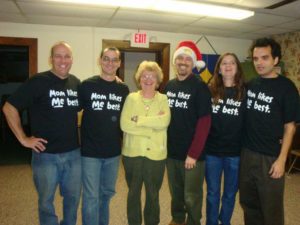
Rebecca with her five children (from left to right Shaner, Mariano, Rebecca, Eduardo, Sonia, Ernâni)
On a personal level, my wife probably would have breastfed our three children anyway, but what a wonderful resource and support system my Mom was during those years. It was such a “luxury” to have had someone that knowledgeable and compassionate available to my wife (and me) at practically any time.
For everything she’s done for the breastfeeding “cause” over such a long period of time, and the loving support for our family itself, I simply want to conclude by saying thank you and we love you, Mom!!”
Love, Shaner
“I have nothing but good memories of Mom and her work with breastfeeding, tons of respect for what she has done for other women. It amazes me when I think of all the women that Mom has probably helped over the years, Moms that she probably isn’t even aware she has helped. And she has never expected anything in return, it’s just always been about helping women have the best mothering experience with their babies.
Mom has never been anything other than supportive and helpful to all of us when it came to breastfeeding our children. We all needed a different amount and kind of support and Mom has always known just how to provide that, without ever being pushy or making any of us feel that breastfeeding was something we “had” to do. I really had no doubts or issues with nursing my children, thanks to my mother. Her gentle guidance was really all I needed. When my daughters weaned Mom was the first person I called, crying, and she comforted me and reminded me of how special that time breastfeeding them had been, again, helping me in just the way I needed.
We are all lucky to have this amazing human in our life, loving, caring and supporting her grandchildren in her own special way! She always knows what to say to them when they need a little something extra, knows what wisdom to share when it might be necessary, and always knows how to make them smile! She loves them all dearly, for who they are!”
Love, Sonia
“Mom is quite an amazing mother. Strangely, I don’t have any real memories of her mothering me when I was a kid to confirm this. I have seen her spending so much time with my daughter, Amelia. She’s so loving, patient, and attentive. It seems like Amelia is Mom’s whole world when they’re hanging out.
I know Mom would say she was lucky that she was able to make her passion as a Mom–breastfeeding–also her passion professionally. She’s made me such a better father and person with that passion–and patience and loving good humour.”
Love, Ernâni
“For me, I knew implicitly that when Cecilia and I had children they would be breastfed. To me, that was the one and only option. And I’m pretty sure that’s because of Mom and all the support she gave to breastfeeding efforts while I was growing up. It was the environment I grew up in, especially since Mom started the first LLL group in Brazil. I still remember the LLL meetings at our house in Maceió with Mom and several mothers, talking about the challenges and joys of nursing. She was a real inspiration to these moms. I certainly didn’t recognise that at the time (I was just a teenager!) but I know that it just sunk in. I can’t imagine a life where my children were not breastfed. And Mom was always there (literally, when she lived with my family for three years!) supporting and encouraging Cecilia and me.”
Love, Mariano
“As the oldest of the Magalhães children, and the first to leave Brazil when we lived there, I did not have as much exposure to Mom’s work with La Leche League. But when she moved back to the US and lived with me and across the street from me in Iowa City, I was quickly exposed to how important it is to our mother to help and encourage women to be able to breastfeed their children. I saw her spend long hours, travel all over the world, talk to officials at a variety of different levels, passionately defending and advocating for women to be able to nurse their children.
On a personal level, I know that Mom made a difference to my wife. Unlike my brother Shaner, I’m not sure how committed to breastfeeding my wife would have been. But Mom made breastfeeding something that my wife embraced, and enjoyed! Like Sonia says, Mom has been able to help women in whatever way they wanted – and whatever their attitude to breastfeeding was. I know that my wife thoroughly enjoyed breastfeeding each of our four children, that the experience was an incredibly rewarding one. And that is in large part because of my Mom!”
Love, Eduardo
Research
The influence of grandmothers on breastfeeding rates: A systematic review BMC Pregnancy and Childbirth, April 2016
Engaging grandmothers to improve nutrition: A training manual for dialogue group mentors IYCN, June 2011
Involving grandmothers to promote child nutrition, health and development. A guide for programme planners and managers World Vision, 2014
Role of social support in improving infant feeding practices in Western Kenya: A quasi-experimental study Global Health: Science and Practice, March 2016
Happenings
Breastfeeding 2018: The Art and Science of Lactation March 9, 2018 in Newton, KS, USA
GOLD Lactation Online Conference April 3 – June 4, 2018
Breastfeeding and Feminism International Conference March 21 – 23, 2018 in Chapel Hill, NC, USA
10th ELACTA Conference Breastfeeding Without Borders May 17 – 19, 2018 in Rotterdam, The Netherlands
iLactation Online breastfeeding conference March 7 – May 7 2018
Breastfeeding in the News
Pictures of Victorian women breastfeeding
Senator becomes first to breastfeed on floor of Australia’s Parliament
“Don’t be afraid to breastfeed here”
The unique way Canada is normalizing breastfeeding
Meet the woman behind the breastfeeding emoji
Working to close the breastfeeding gap
